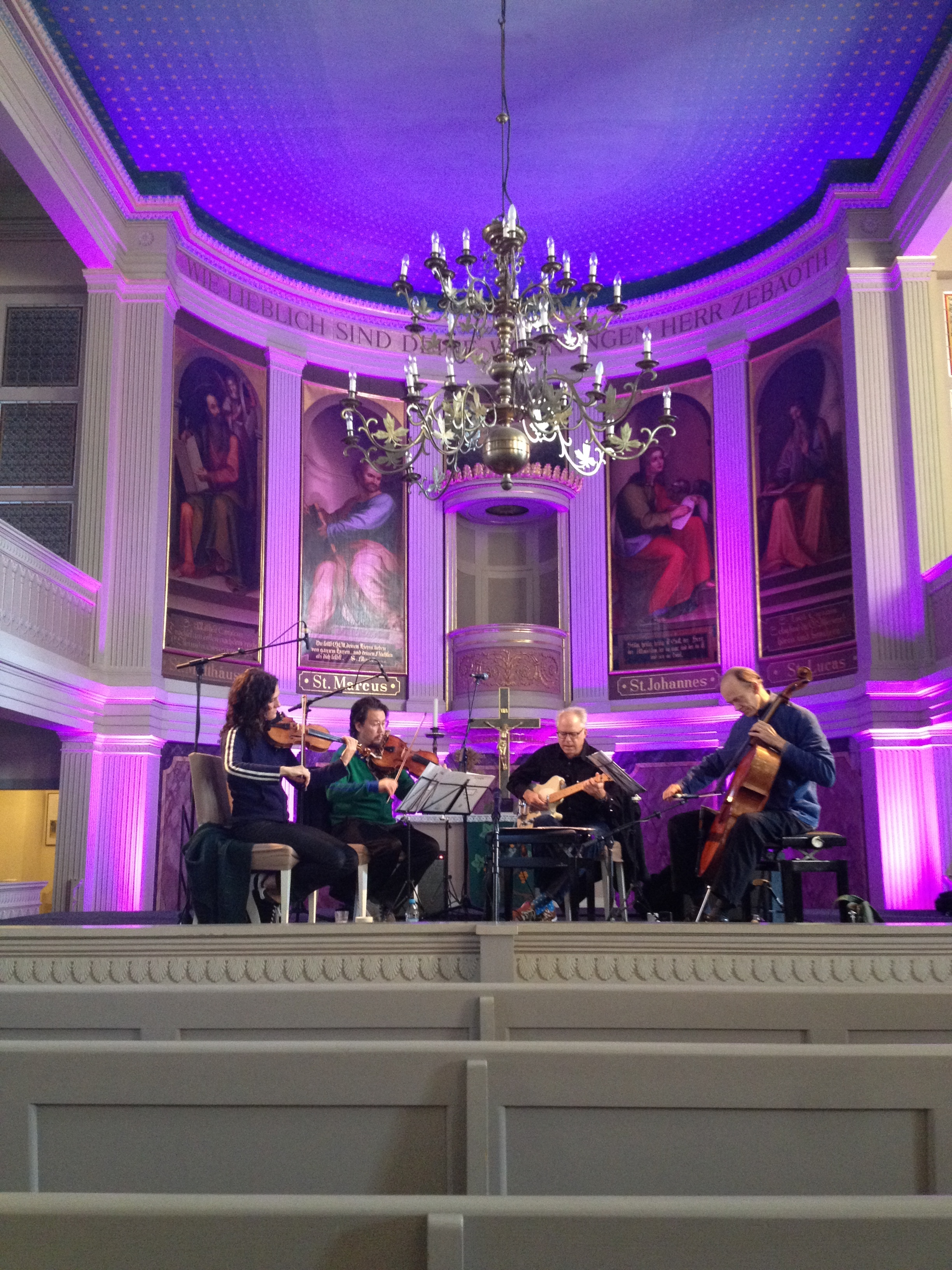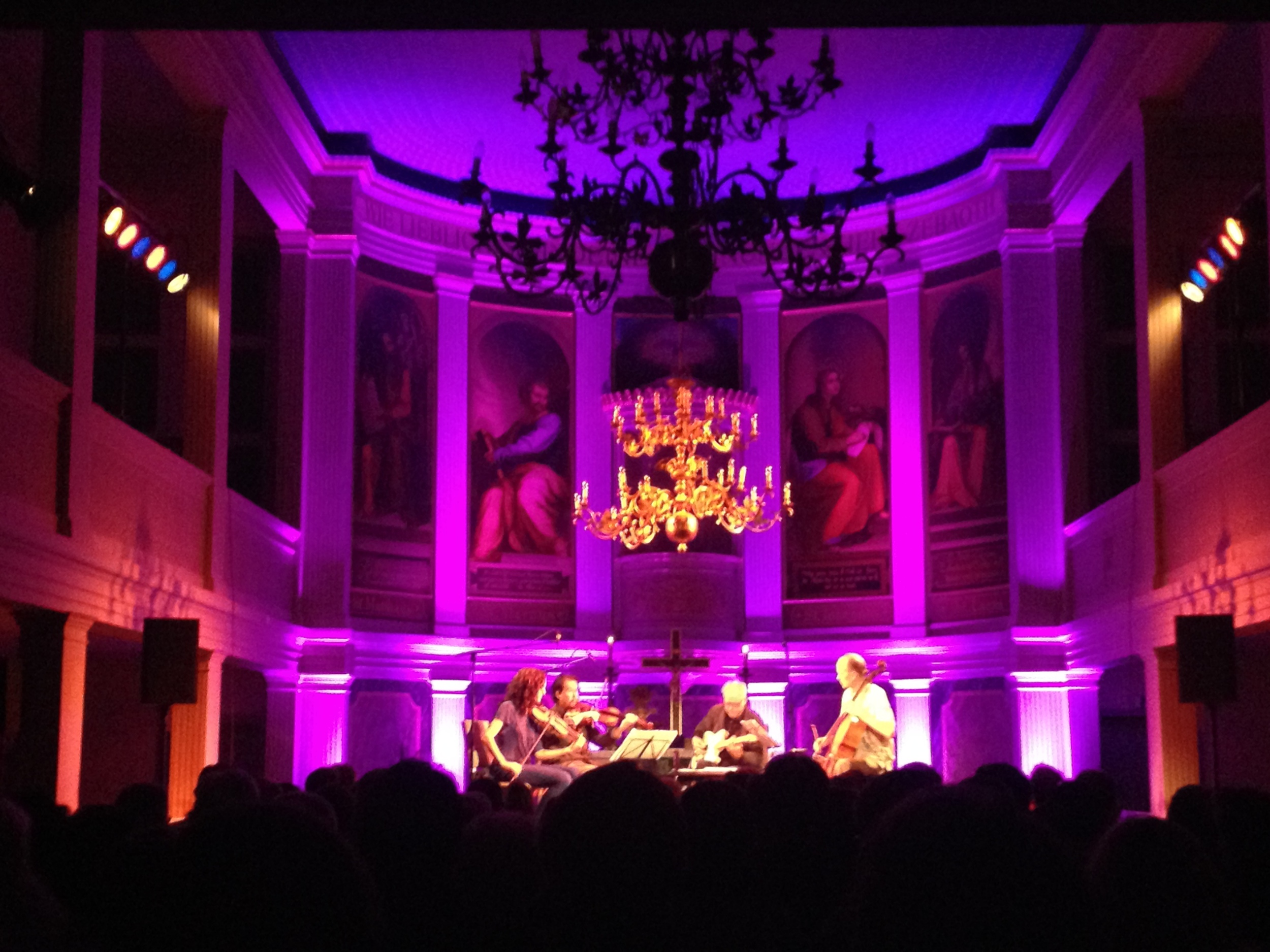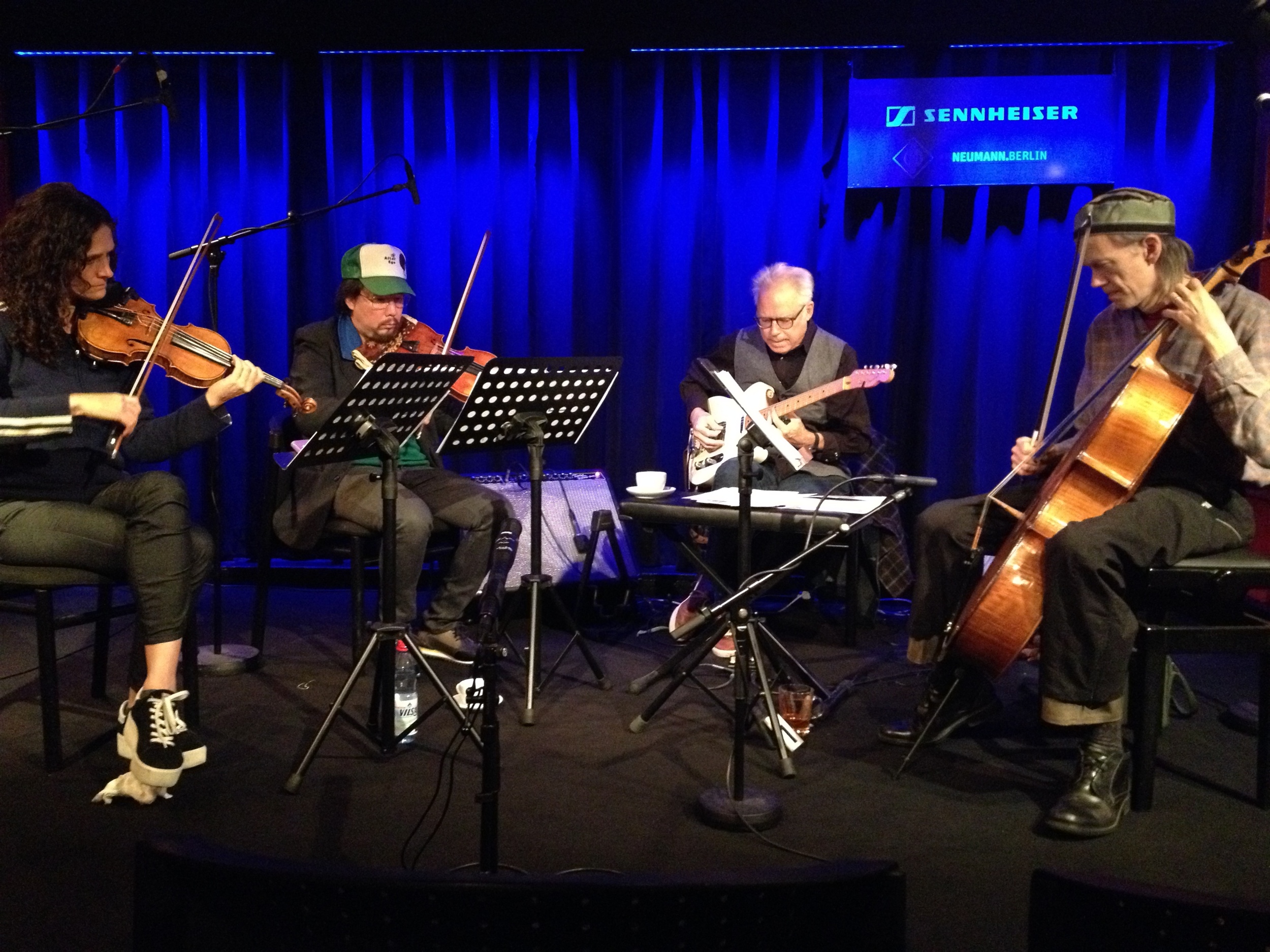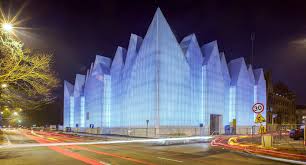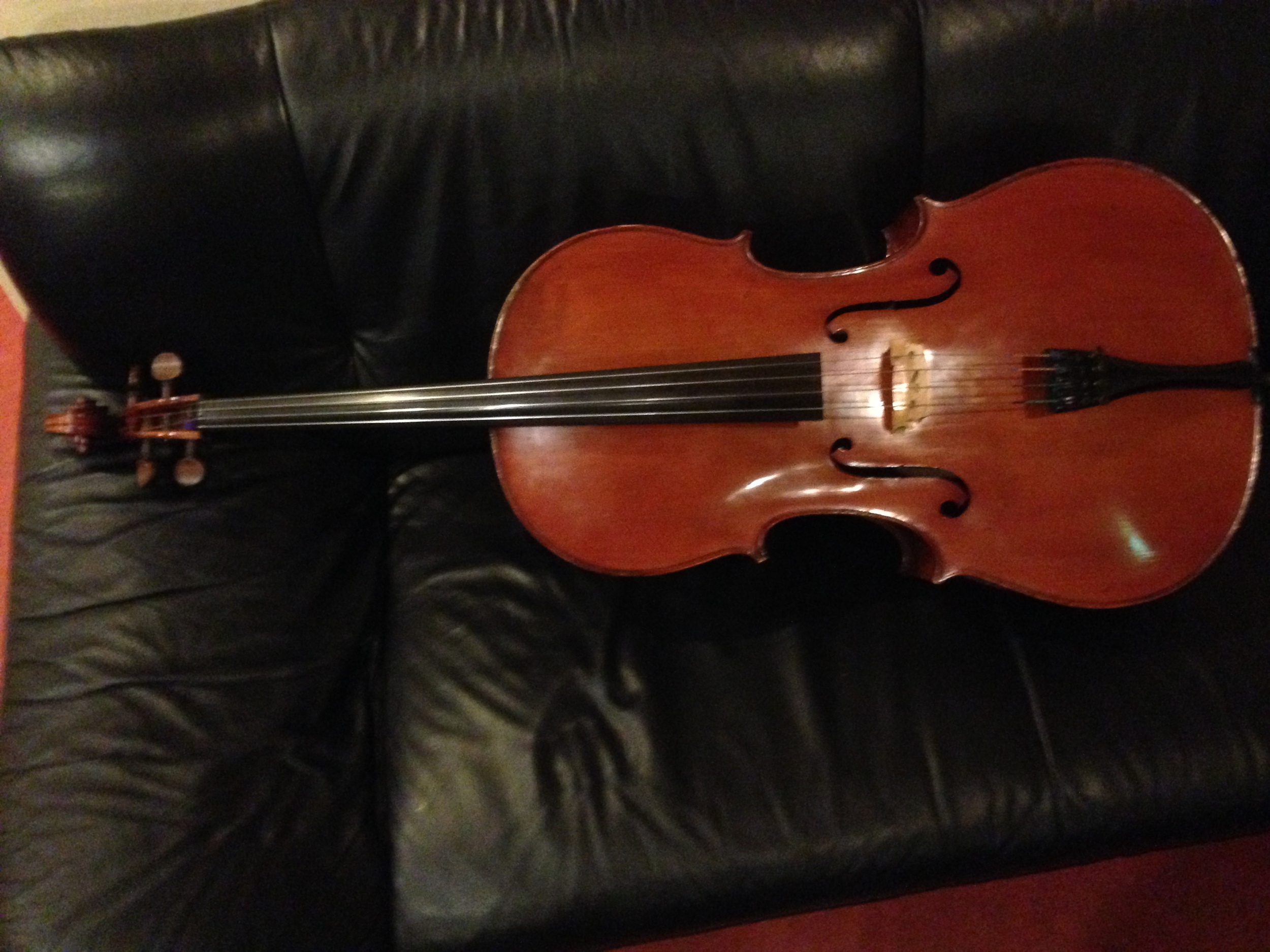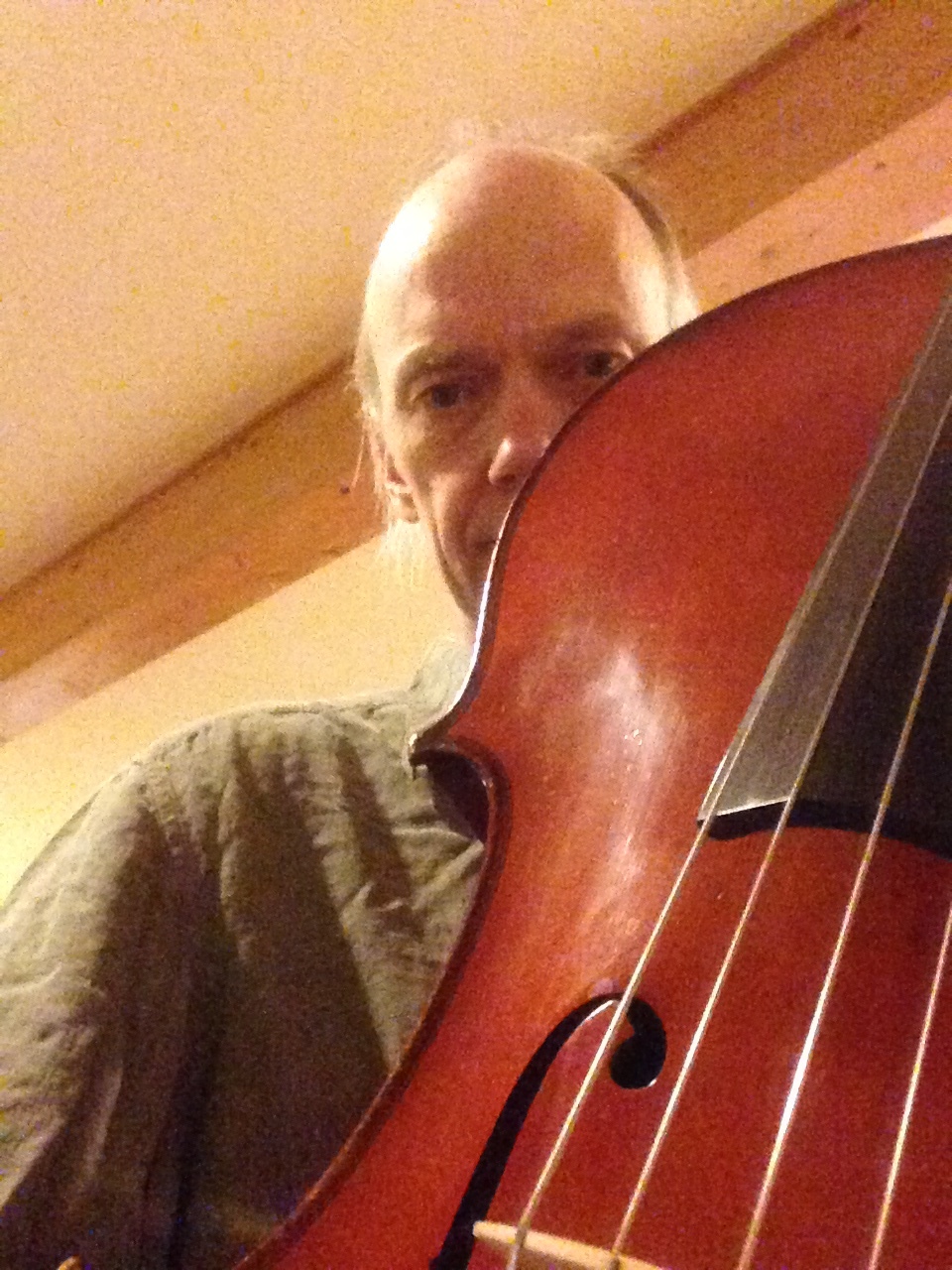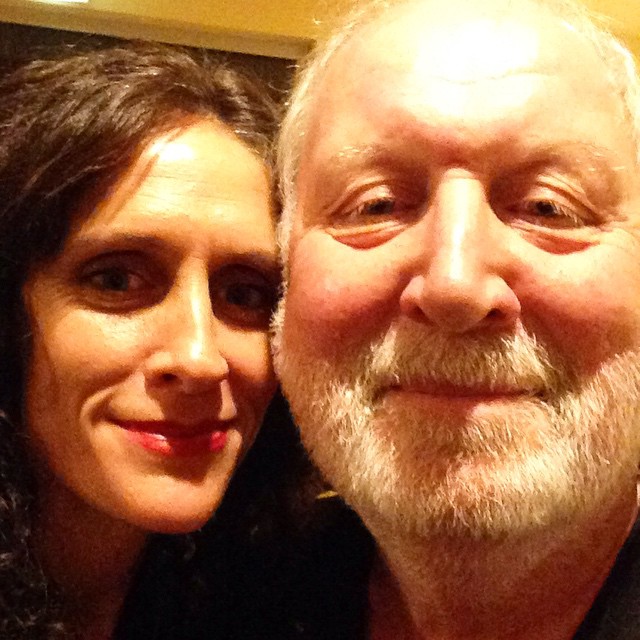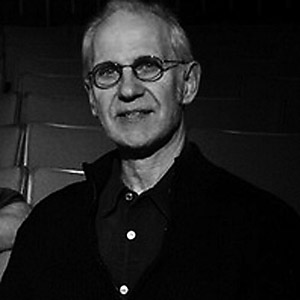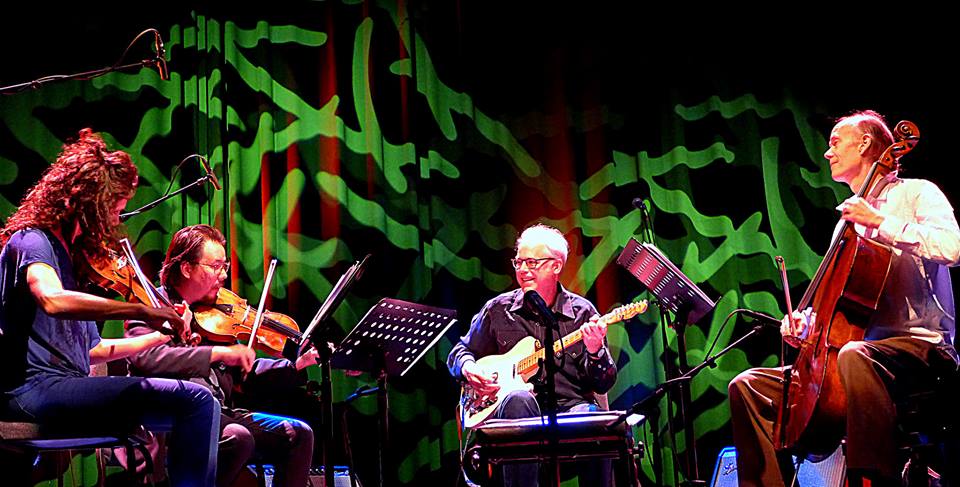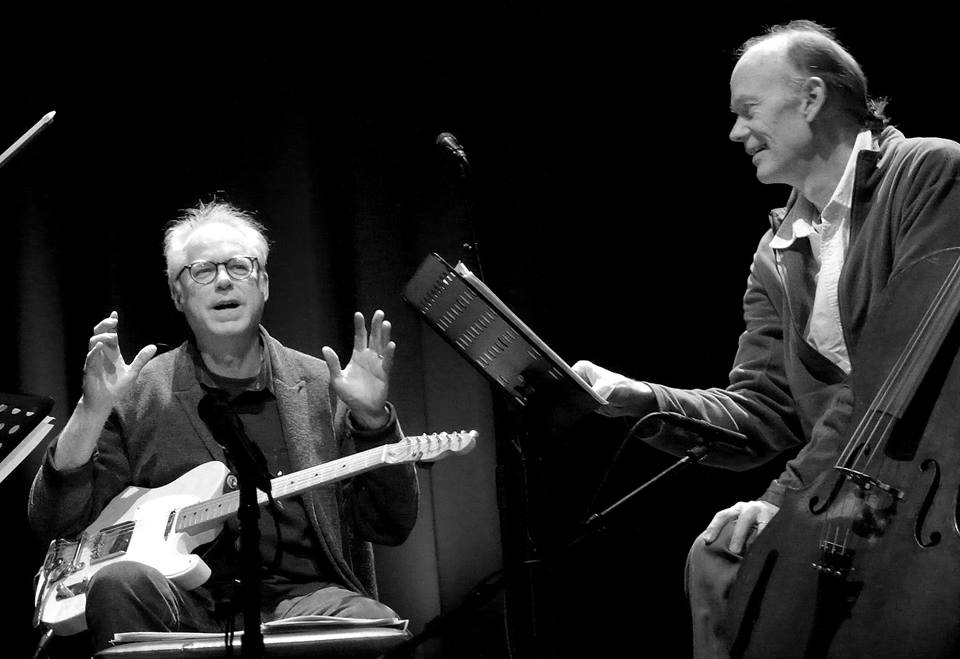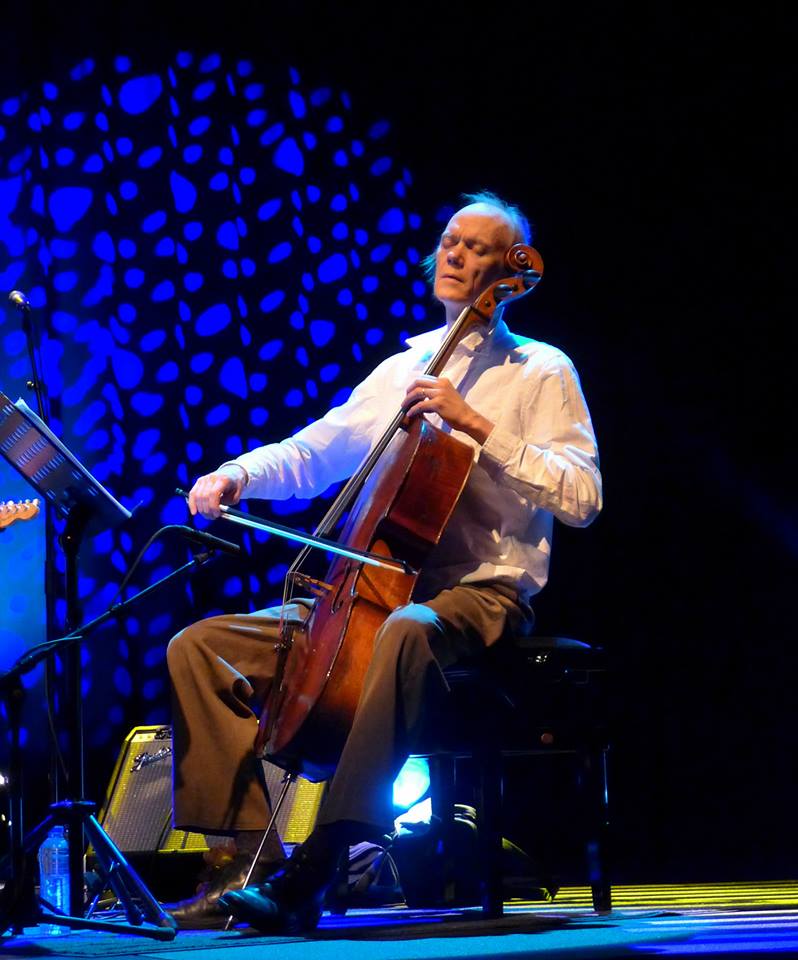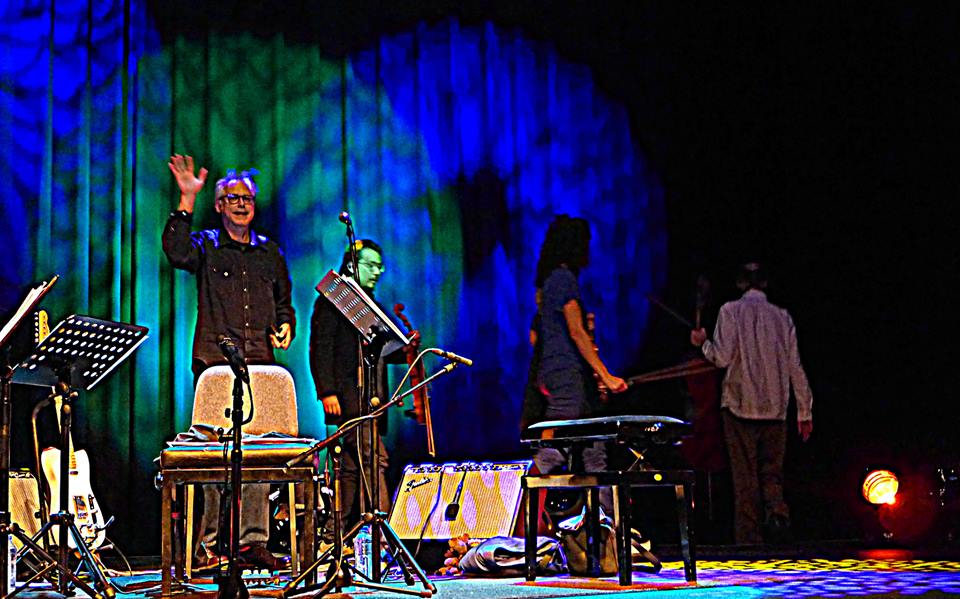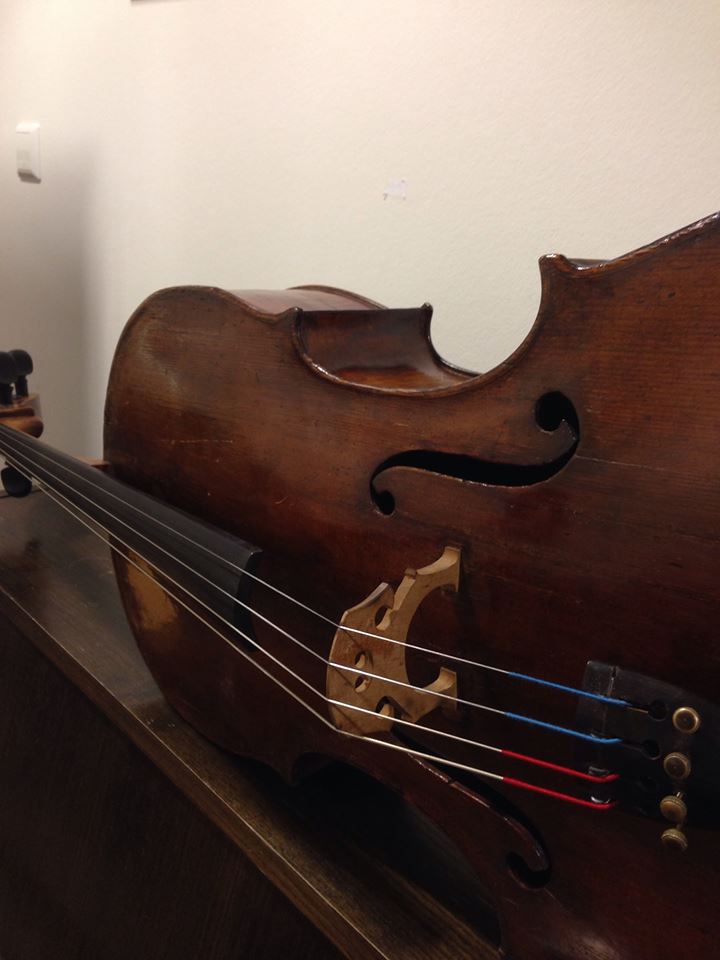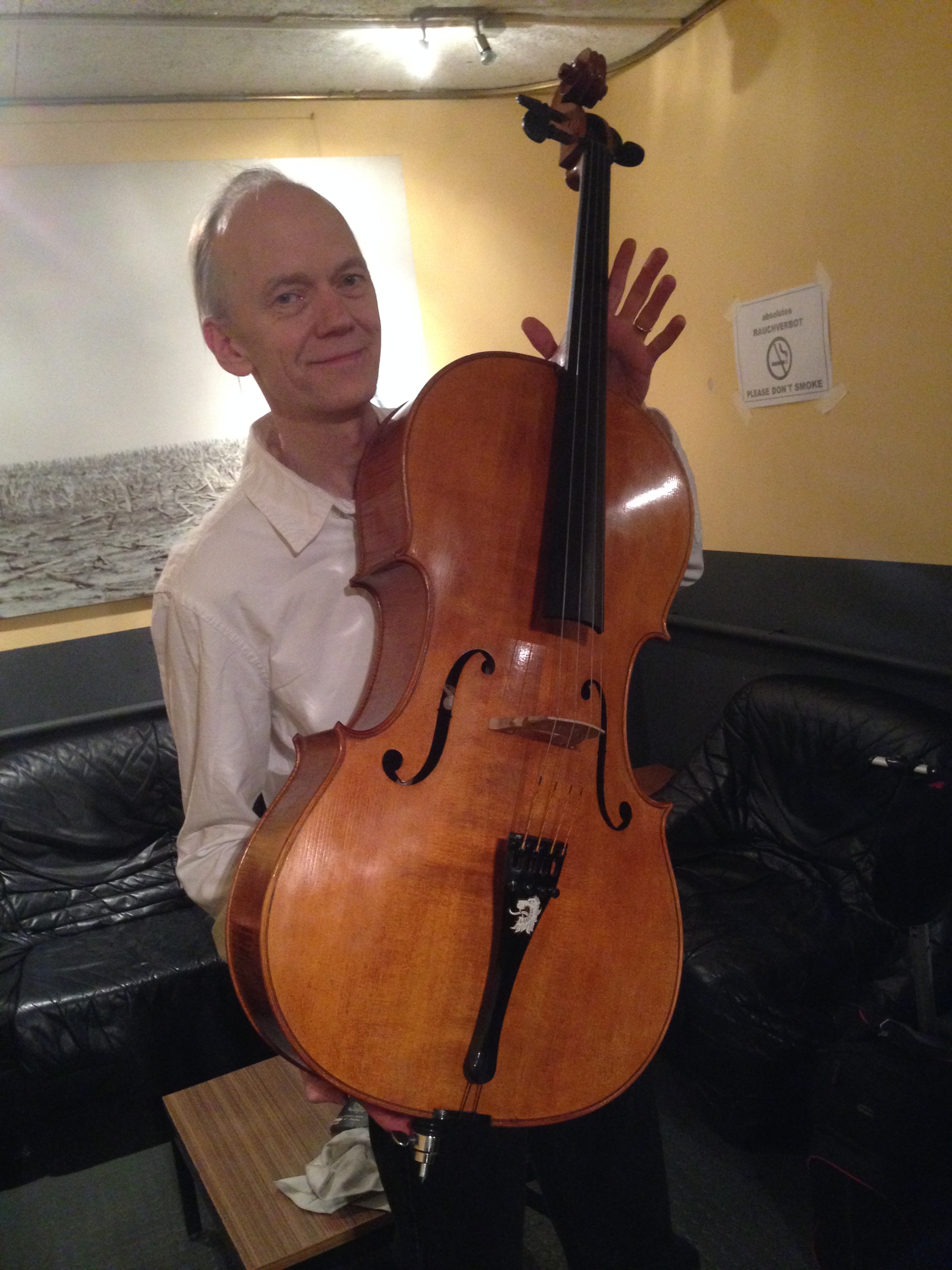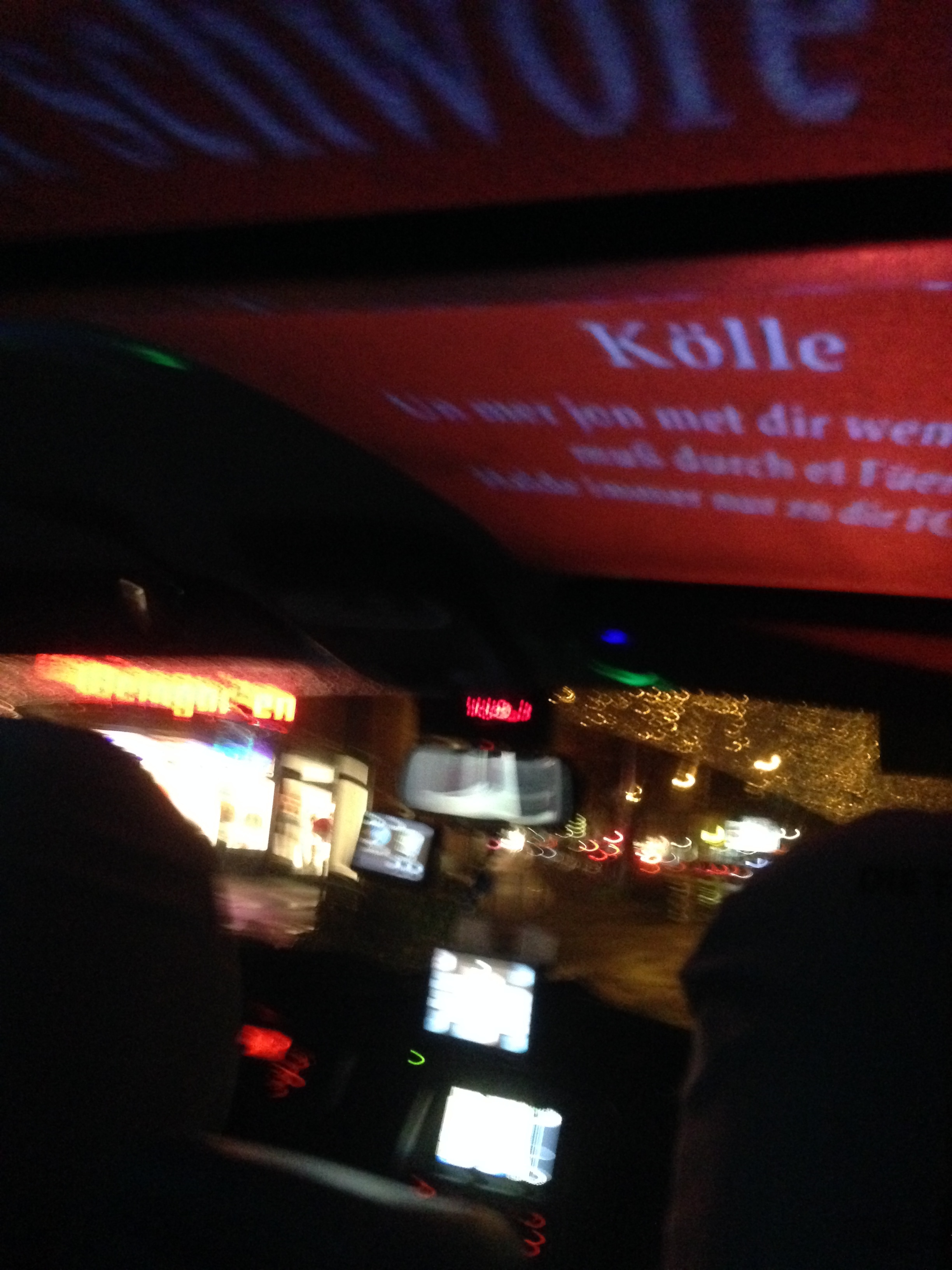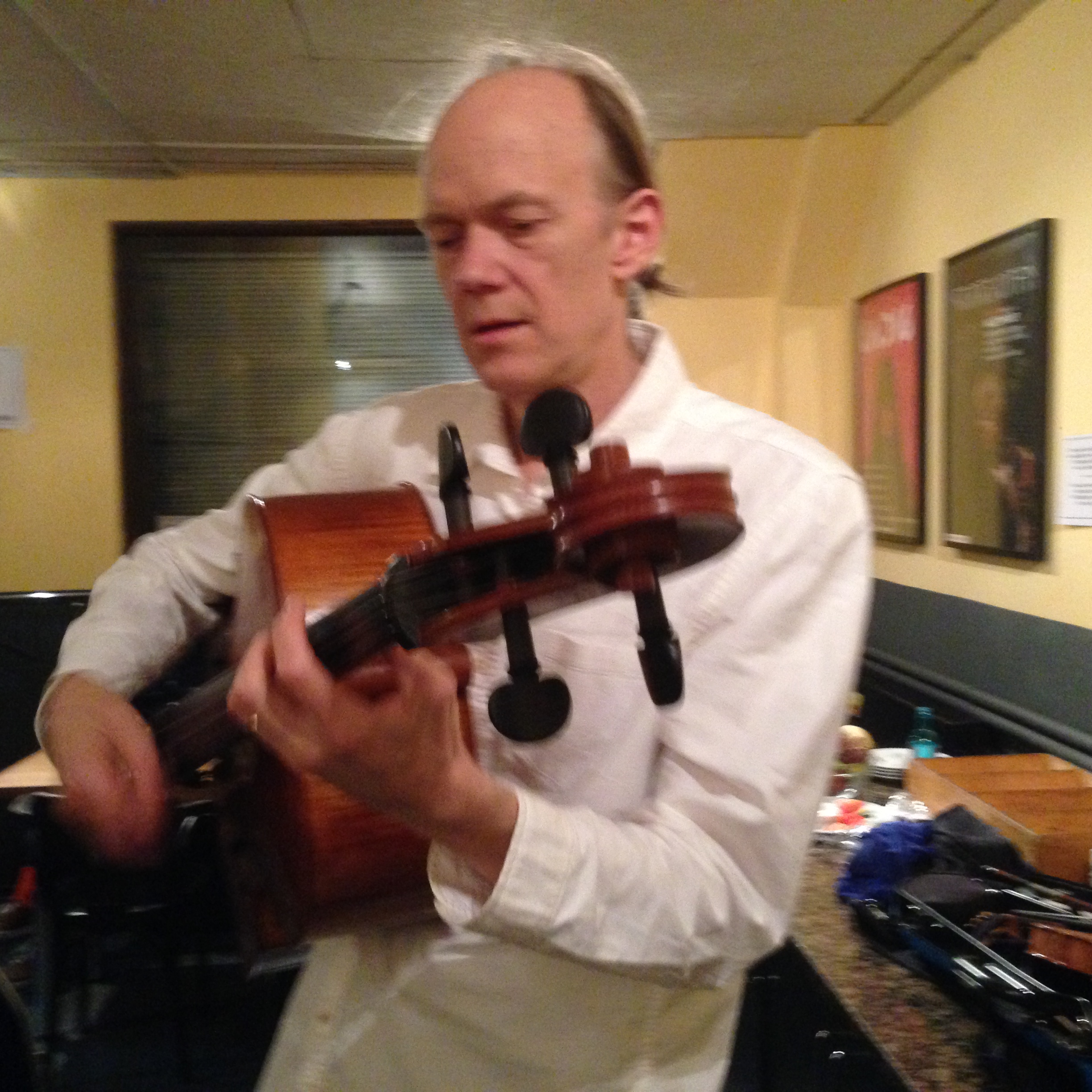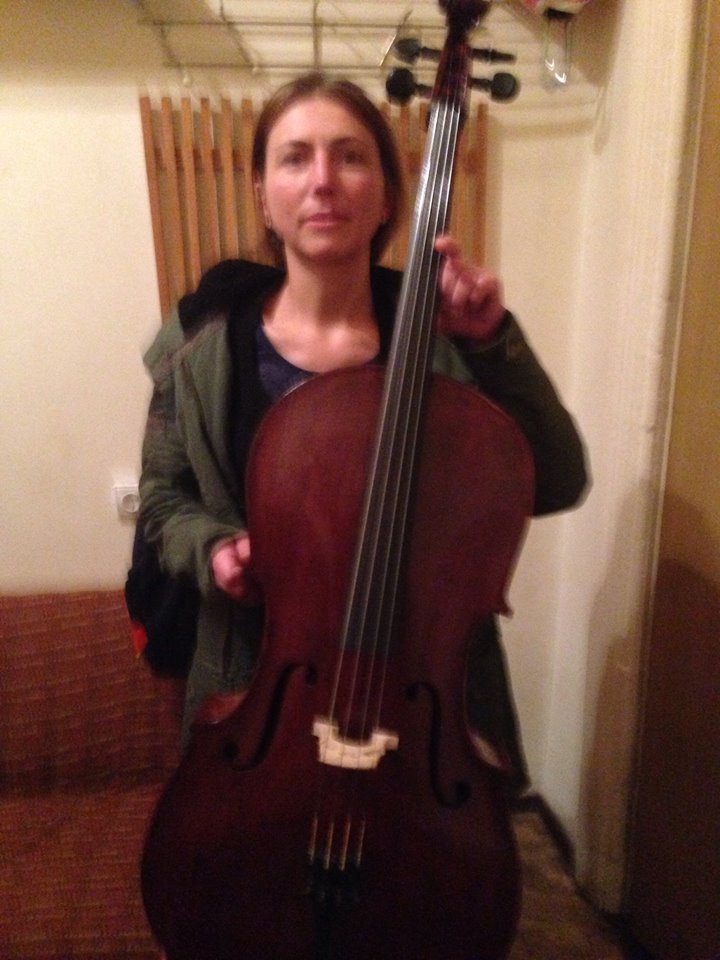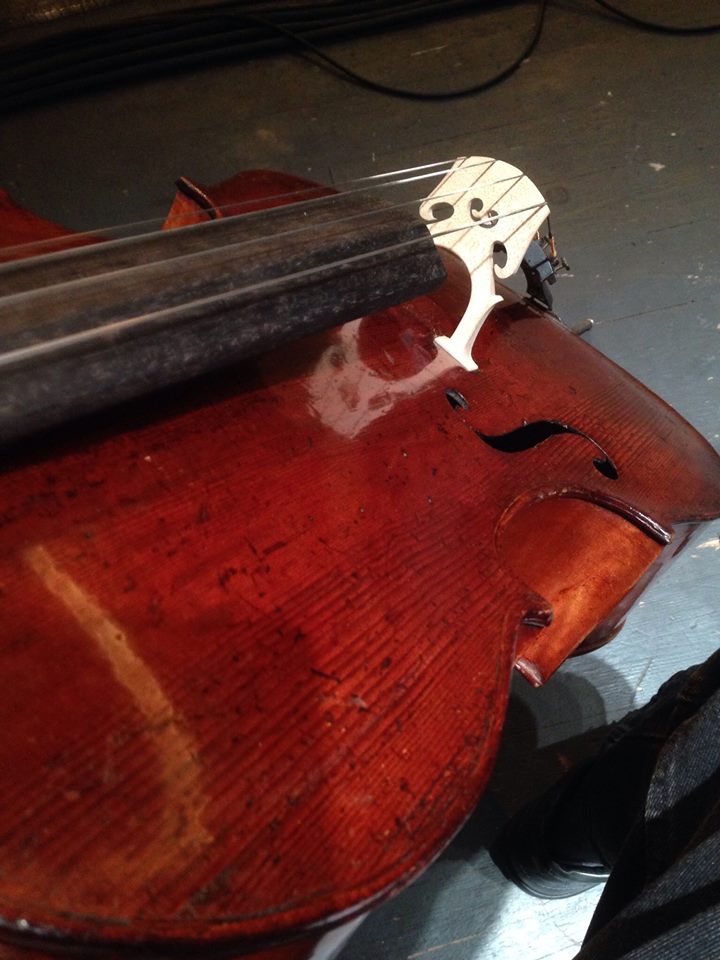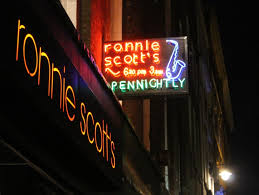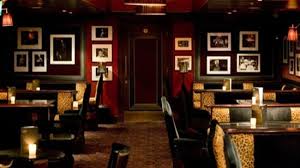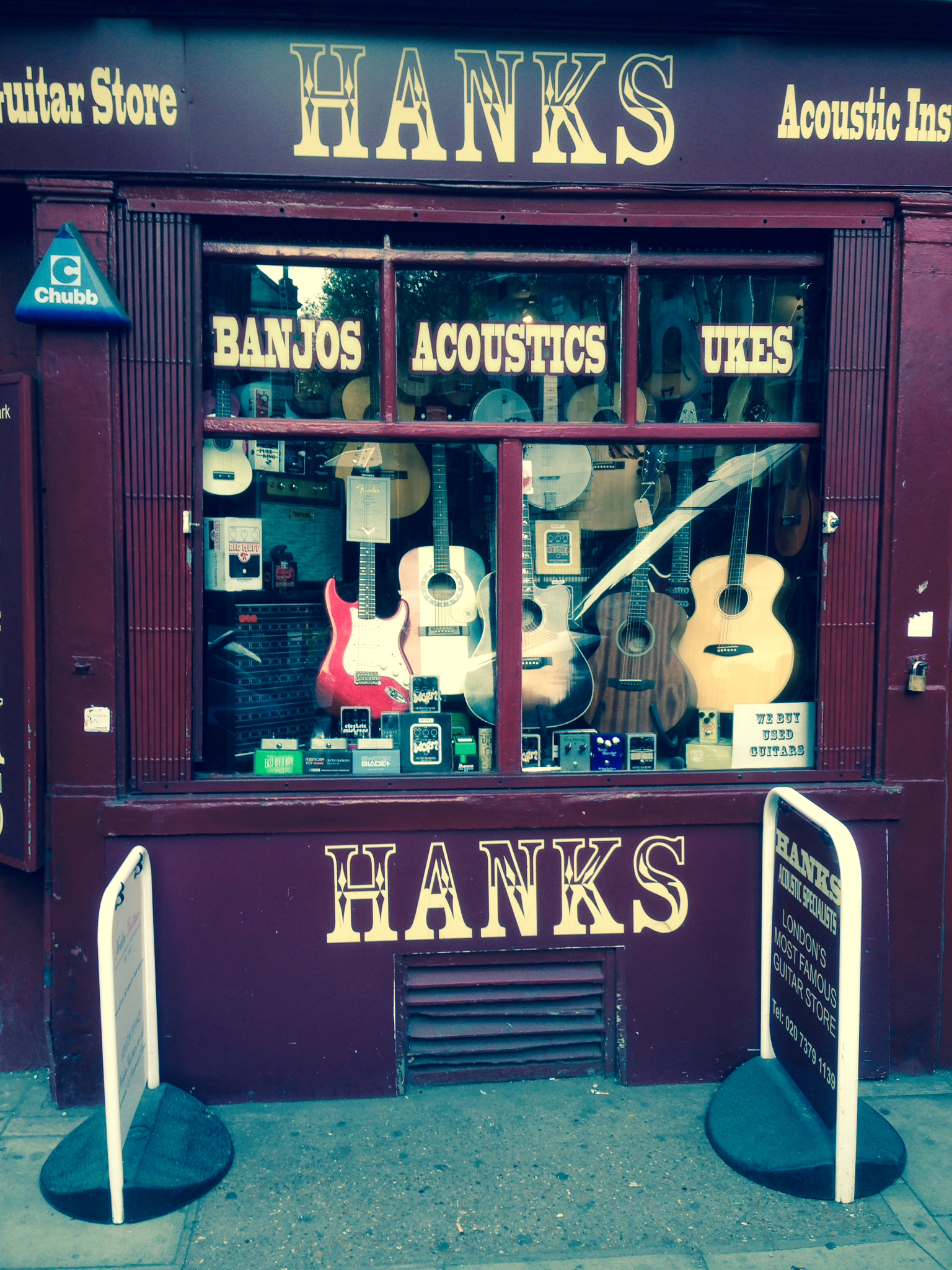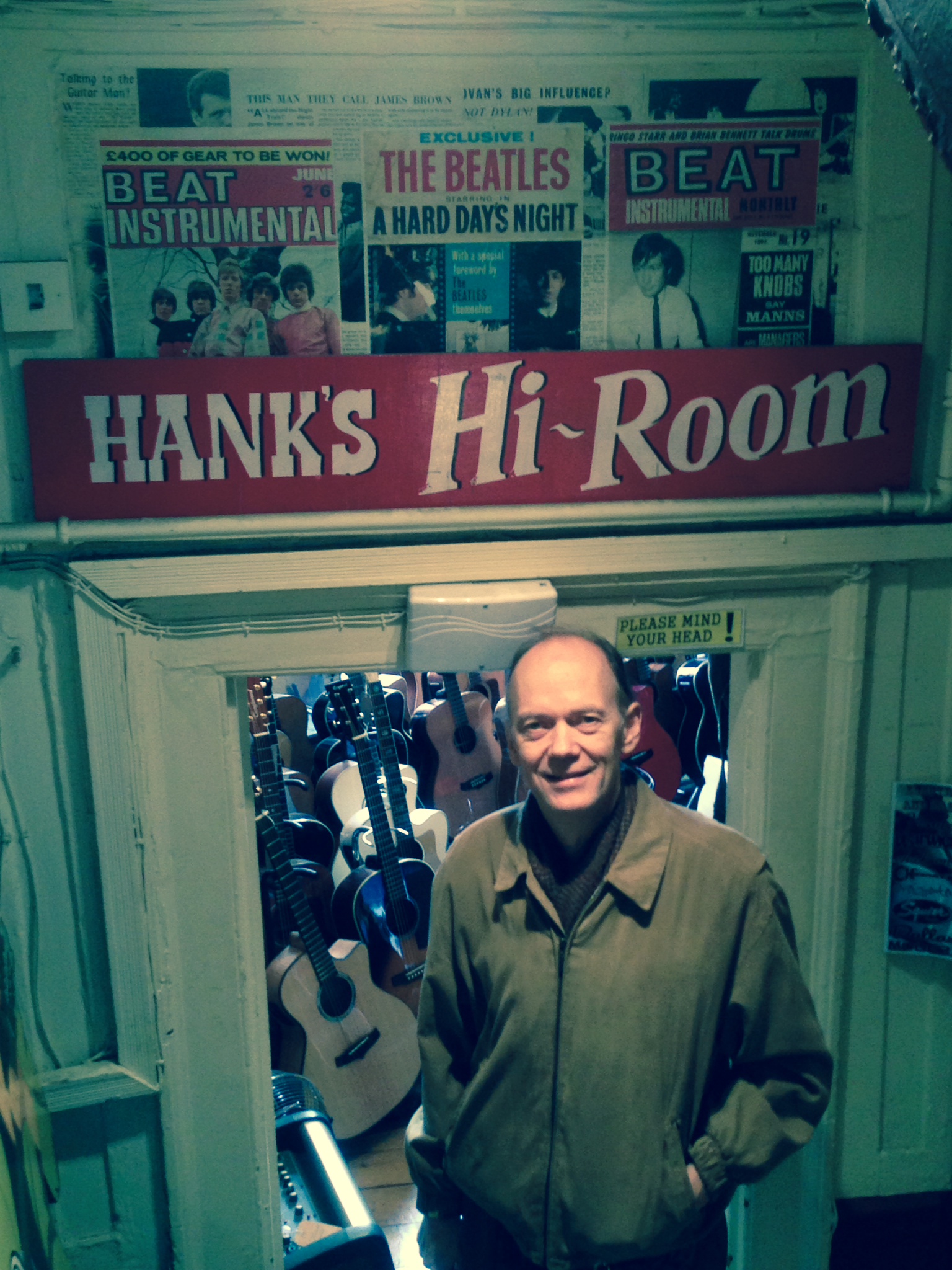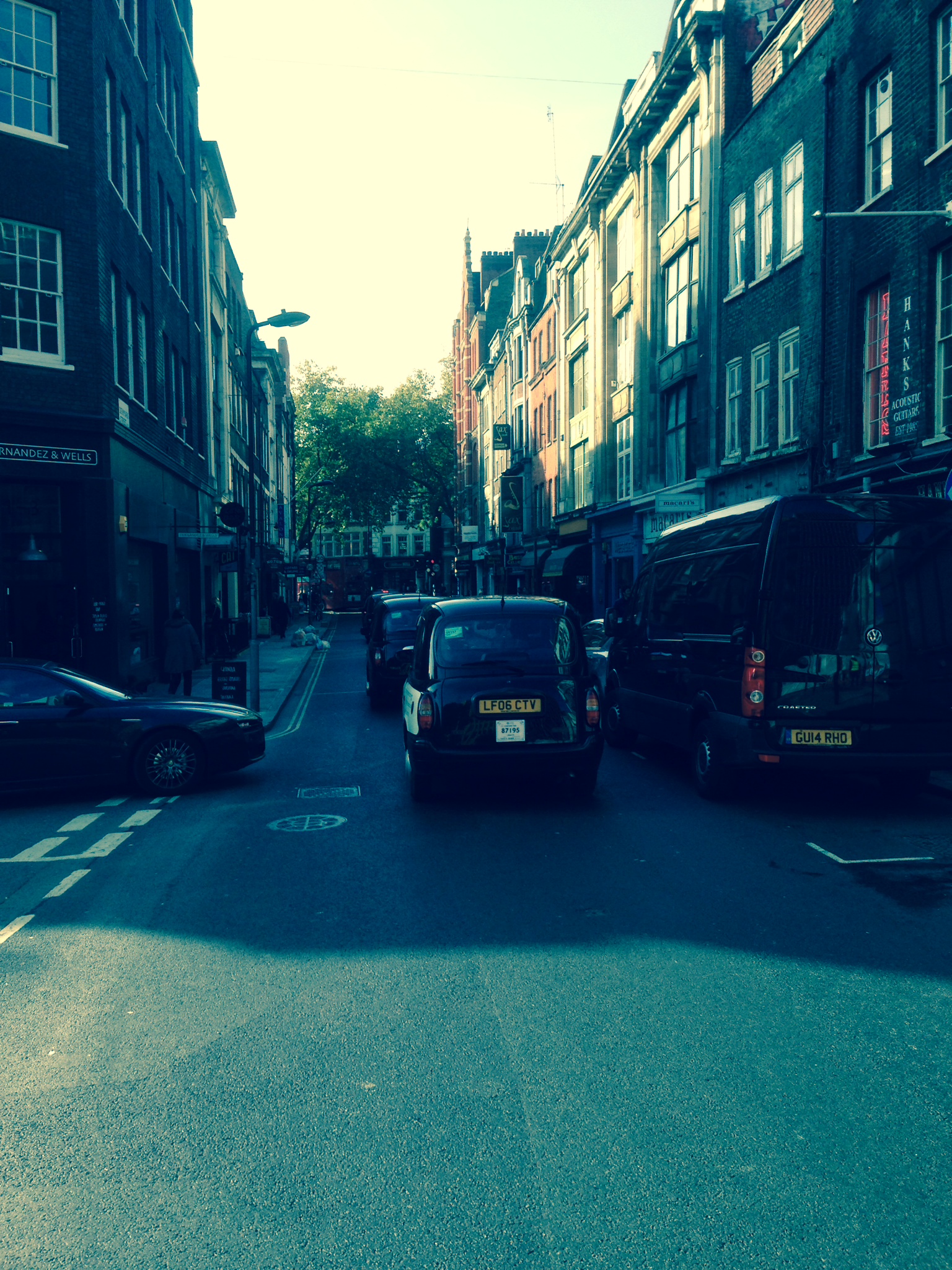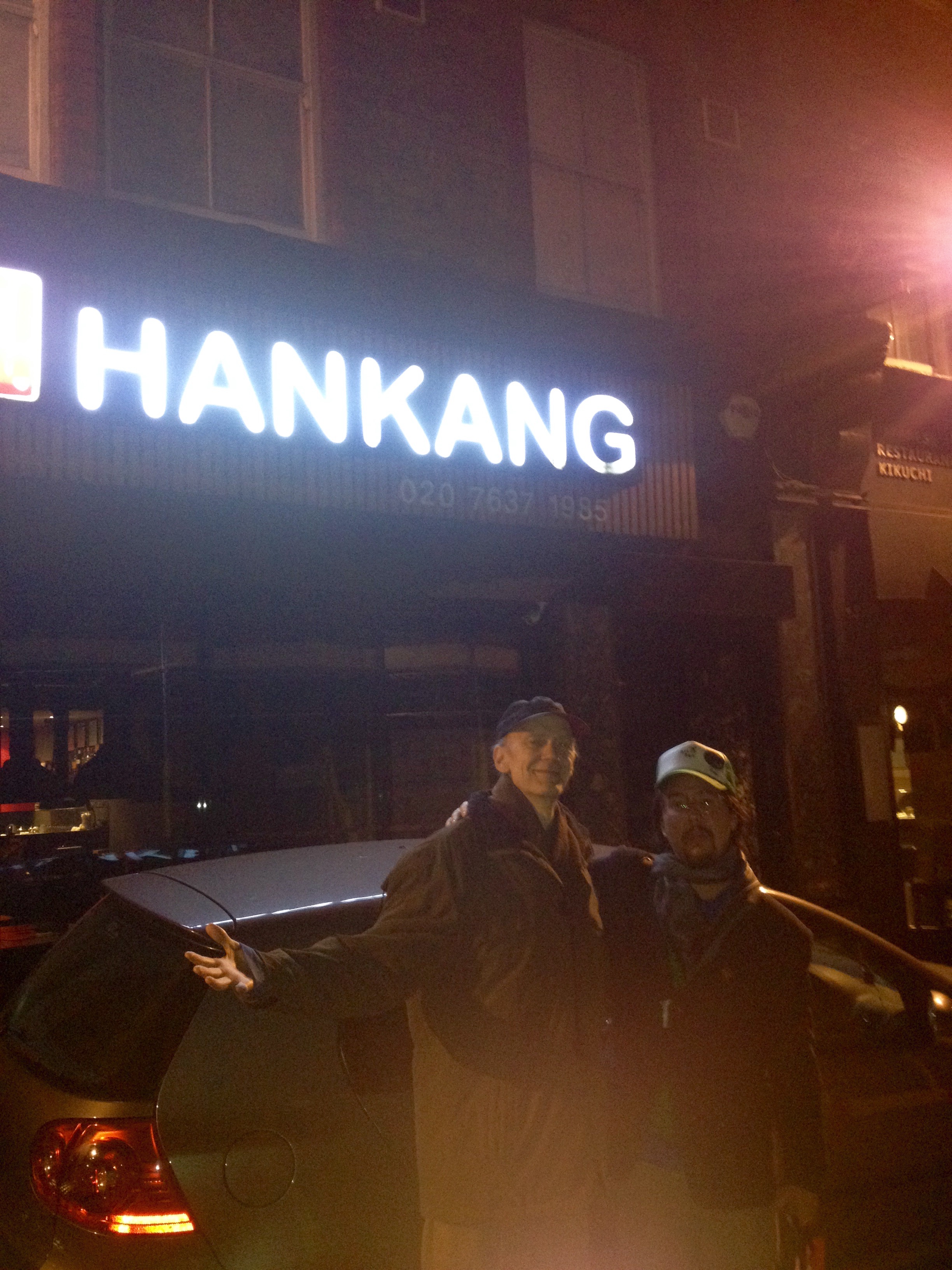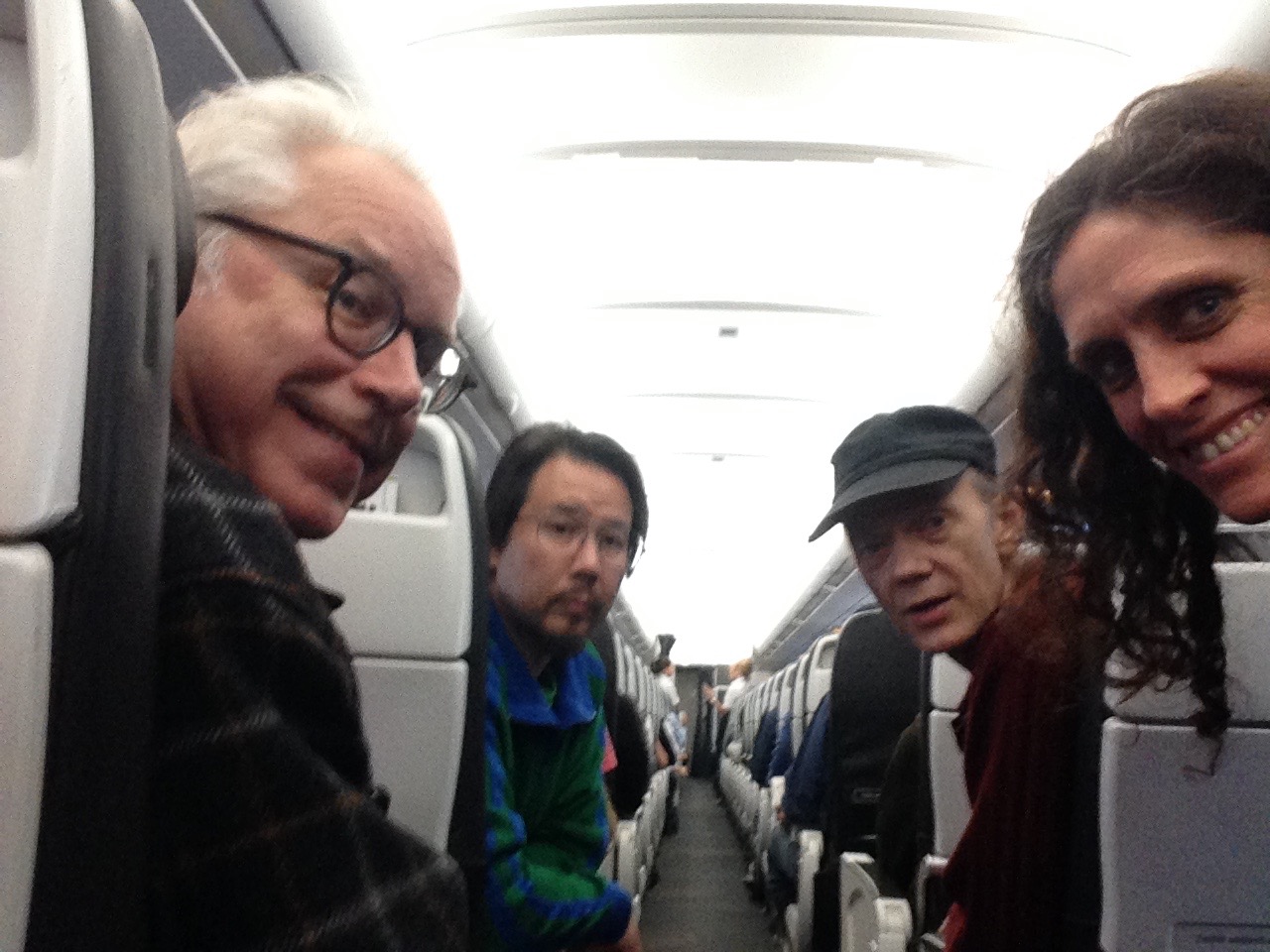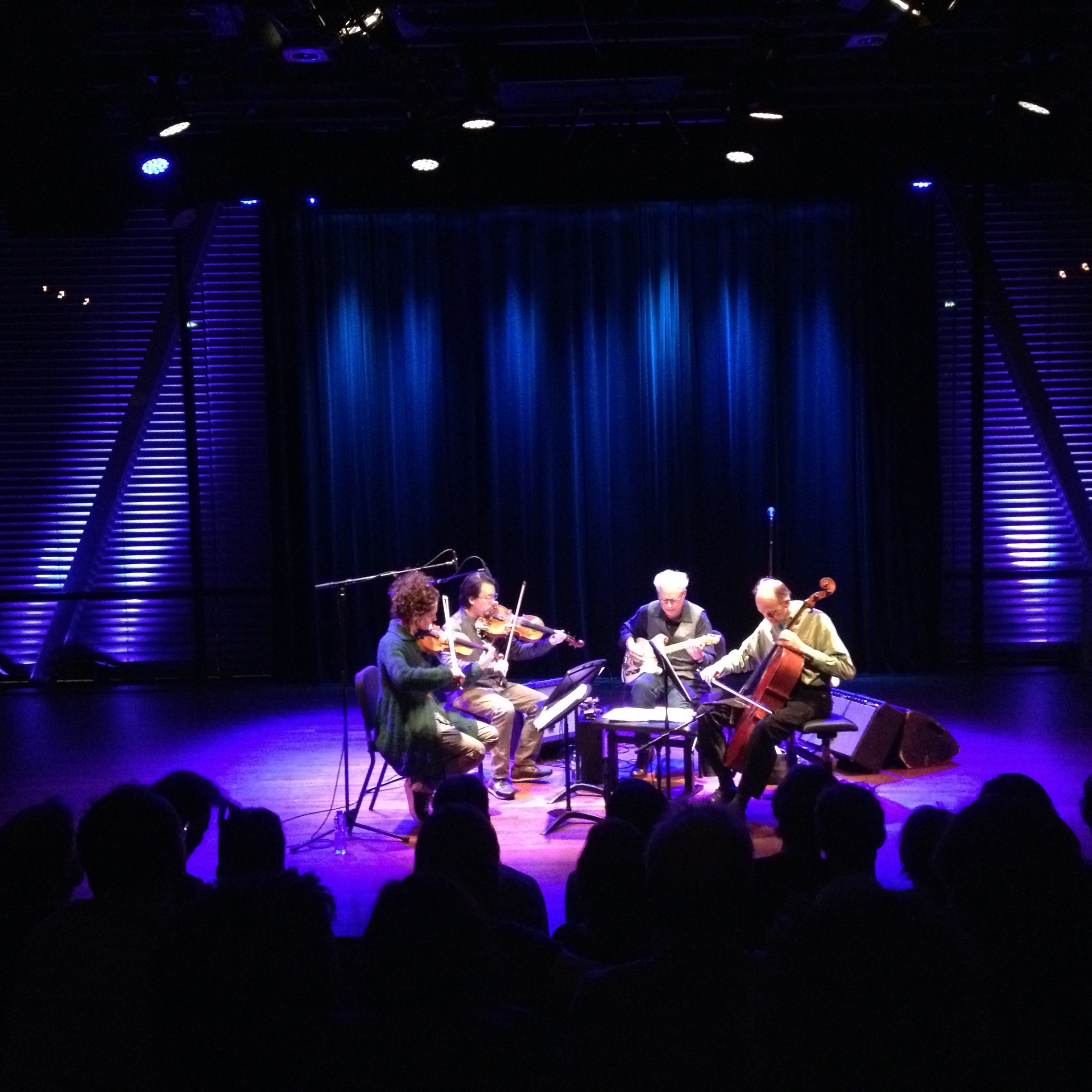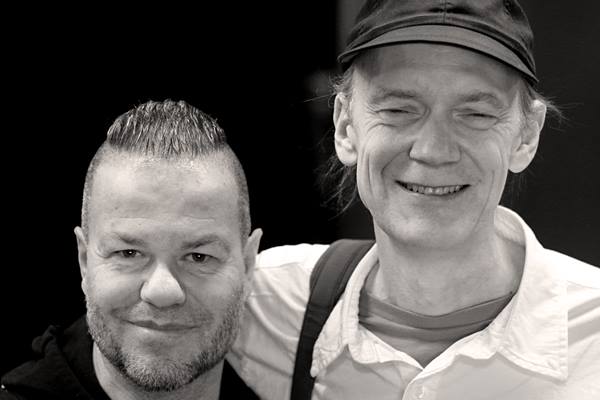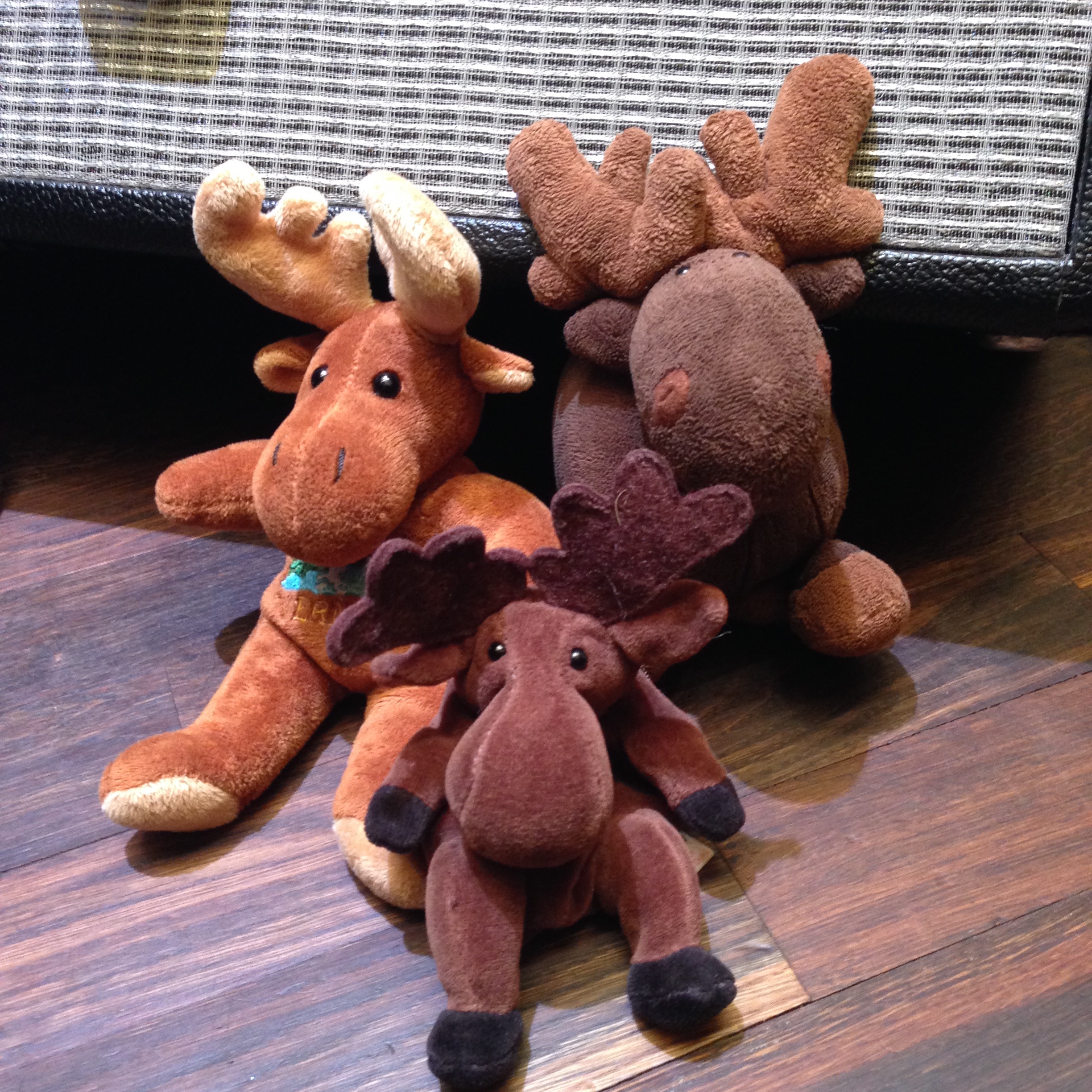cello du jour
A different cello for every concert (15 concerts in 16 days) on Bill Frisell's 'music for strings' European tour october 2015
with bill frisell on guitar, Jenny scheinman on violin, eyvind kang on viola, and hank roberts on cello.
I decided to try something different. Drummers, pianists, and bass players do it, and so I thought that I might try borrowing an instrument for each of our concerts on this tour. I put together a rider with some specifics for the kind of cello that I wanted, and our managers and booking agents sent them out to the promoters at the venues. The following is a daily diary or blog about my adventure with cello du jour. I enjoyed playing all of these instruments, and sometimes I struggled with some of them a bit (which sometimes meant that I might potentially be struggling with myself in some way).
Without Phyllis Oyama, Claudia Englehart, and all of the fine individuals at Saudades Tourneen, especially Barbara Achatz, Jakob Flarer, and Anna Tagats, this couldn't have happened. They stayed on the case and generated a lot of energy and communication with the promoters and venues about getting cellos for me. It's not common for cellists to leave their instruments at home, and all of these folks, including the promoters, supported the idea in a wonderful way.
neuhardenberg, germany at 'schinkelkirche' oct 10 2015
Our first concert of the tour with Bill Frisell and The 858 Quartet in Neuhardenberg, Germany (near Berlin). I'm playing borrowed cellos at each concert, and I've been in heaven playing the one that I got for yesterday's rehearsal and tonight's concert: a beautul old Italian instrument made by Francesco di Emiliani (1704-1743) almost 300 years old, 'ferit Roma anno 1723'. I felt so fortunate and had such a satisfying time playing it. 'stayed up until midnight last night playing it in my hotel room (very quietly with a mute on). 'felt a little touch of sadness giving it back after the concert this evening. It has great responce throughout, particularly impressive in the upper thumb position on the C string: surprisingly clear and beautiful. It was exiting to feel and hear the sound open up the more that I played it and found what it's character is, and how it would best respond. I wonder what would happen if I had more time with it. The look of the instrument is quite unique with accentuated depth in the top and back curvature, and the feeling of being a bit small, almost a 7/8th's size.
hannover, germany - 'jazzclub hannover' oct 11 2015
Hannover soundcheck and Hank with cello backstage
A cello made by an undetermined German Luthier, probably about 100 years old, according to the owner.
I met the nice gentleman from the Hannover Symphony who loaned his cello to me. He has an appreciation for improvised music, and was generous to let me play his cello, and bring it to the club for me.
'spending some time talking with this instruments owner before our soundcheck brought forth some interesting reflections while playing it in the concert.
Playing a different cello every night has been an awaking type experience for me. Sometimes I mistakenly make an early judgement as to whether or not the instrument works for me or not, and then only to be surprised after playing it for a while. I didn't have a lot of time with this cello before the concert. We had a short soundcheck in a small Jazz Club. Right before the show, I felt that it could have been better to have a bit more time, and I was still looking for the best approach to the instrument, but when I hit the stage for the first piece of the first set, it seemed that I found how I could approach this cello (which added to the excitement of the set for me from this gentle revelation). Usually, I would air on the side of not being too pushy with an instrument that I'm unfamiliar with, but this time I put some substantial energy into it, and found a unique woody, and multi dimensional sound. It was like the whole instrument got bigger, and then after being 'pushy' for a while, I backed off and found a softer sound as well. I was aware of 4th position feeling further down the instrument relative to where the upper bout is (compared to what I'm used to), and so I kept that in mind. Playing the cello is about being awake and constantly adjusting for intonation and timbre, so it's a natural process anyway.
SZCZECIN, POLAND MONDAY, OCT 12TH AT 'THE FILHARMONIA'
(A BEAUTIFUL NEW HALL JUST A YEAR OLD).
This was a day full of cellos. The wonderful folks from the venue provided 2 cellos for me to try. These were very nice modern high -end student cellos. I choose one with a big edgy sound and comfortable action, and played it through the soundcheck. much fun. Then, the owner of the 18th century Italian instrument that I played in Neuhardenberg showed up with the cello, and I couldn't resist playing it again that night. He had missed the concert in Neuhardenberg, and so kindly made the trip to Poland to bring the cello and to see us play. I also had written to him, in order to stay in touch with him about the instrument, and to possibly connect for future tours. For Contrabass players and cellists, I highly recommend his rental shop (filled with beautiful pre-1930's instruments) located in Berlin. Wolf Settgast www.berlin-strings.com
bremen, germany - 'kulturzentrum schachthof' oct 13 2015
Pictured above: Roger Graham Hargrave (the luthier who made Jenny's violin) with Jenny, and Volker Steppat.
A beautul old French Cello. Ch J.B. Collin-Mezin, Paris 1925.
This was one of my favorite cellos of the tour so far, absolutely beautiful sound and feel, and another one that I would love to take home with me. It was not so easy to give it back at the end of the night. The low end was glorious, with plenty of highs to project that area of sound, and a broad spectrum of colors throughout all registers, making the mid-range and higher notes beautiful as well. At one point during a solo cello section, I found myself producing sub-harmonics tones creating pitches an octave below their usual placement on the cello. That was one of the highlights and inspiring discoveries with that cello during the evening for me. This instrument was ready for anything: so much fun, and satisfying to play. I hadn't played in Bremen for a while; maybe it's been 25 years or so, and the promoter was someone who organized concerts for me in the 80s and early 90s, Volker Steppat (pictured above). It was great to see him, and Arne Schumacher, another friend from the past, who was the representative from radiobremen recording the show last night. I felt a bit of home-coming feeling from them and the audience, and the group played an inspiring set of music. All-in-all a very special evening, and another magical cello connection. Interestingly, our violinist, Jenny Scheinman has a wonderful violin made by a gifted English luthier, Roger Graham Hargrave (pictured above with Jenny), who now lives in Bremen. He came back to the green room after the concert, and talked about making Jenny's violin, the wood purchased from Hill's in London had been aged for 100 years.
Rotterdam, netherlands at 'lantaren venster' oct 14 2015
This cello was very humble, with no identifying label inside, and I estimate that it could be anywhere from 40-50 years old, or possibly older. It had a relatively flat curvature on the top, some very humble looking strings and was a bit dusty. The tone was very quiet and somewhat 'flat', and in general this instrument was in stark contrast to last night's French model. The action was very low, so it was easy to play, but when I played loudly the strings could thus potentially hit bottom (and rattle a bit). After having so many great instruments to play this week, I felt a bit disappointed at first, but rallied my sensibilities and attitude and put some love into it. I enjoyed the easy nature of the low string height, and happily realized some of it's special tonal qualities. As the evening progressed, I realized that it was a much better instrument than I initially thought. Interestingly, the rest of the group kept 'standing up for this cello', telling me that they liked the sound, and the way I was playing it. The message that keeps coming to me is that every cello, especially ones like this that have been played and played for years, has something special to offer. I'm really glad that this instrument came my way.
All of the photos above, except the cello photo, were taken by Brigitte Soffner
Köln, Germany at 'The Stadtgarten' oct 15 2015
I've played at The Stadtgarten over the years probably more than any other concert venue in Europe. I've known the promoters off and on for about 30 years.
Last night's cello du jour, a non-labeled instrument which seemed to be 'hot off the press', looking brand new. Student-type instruments like this one seem to be getting better these days, and I'm starting to think that maybe 'I've never met a cello that I didn't like' (and perhaps there was merely a misunderstanding at hand, if I did dislike one). The tone was kind of harsh, which I often find to be the case with 'student level' cellos, but it was acceptably tonally moldable, and it could be played in tune. We were doing a lot of tuning in between pieces. I wondered if this instrument had new strings on it, but the heat coming off of the lights was probably also affecting the strings.
The cello du jour theme has been a regular topic and source of mild entertainment within the group. Some of the cellos have even received names. Claudia, doing nightly sound from the board has the eagle's eye view on the sound perspective. Plus, she used to play the cello on a regular basis as a young person, which of course gives her even more cred with me on this issue. She offered that, although acceptable, there was nothing particularly unique about this cello. I agree, and it made me think about the dusty 'ill-kept' (perhaps a 'creative label on my part) cello from Rotterdam, which I was somewhat initially disappointed with. Perhaps it was not the ideal sound and feel that I was looking for in a cello, which might be an instrument with a broad range of timbrel personality, and a deep and 'outwardly' expressive (loud?) sound; but on the other hand it had a lot of character, age and 'experience', all extremely valuable characteristics for an instrument. I've begun to appreciate it even more retrospectively.
I wonder if the fact that I often perform in groups that have electronic instruments and drums has led me to prefer instruments that have the potential to project more. Maybe that's partly true, but actually it's more complicated than that. So far, there have been 2 cellos on this tour that have really caught my attention: the first one that I played, a 1723 Italian instrument, and the 1925 French cello I played in Bremen. The latter in particular, (and with the understanding that I only played it for one evening) represents to me one of the highest degrees of sonic possibilities that I've experienced playing another cello besides my own. I have 2 cellos, an old French instrument, and a pre-1940's German student-type instrument. I've been playing the German cello quite a bit recently. My Dad bought it for $35 from a pawn shop in the late 80's, and it was in fairly rough shape, but not severely damaged. I loaned it to a student for a while who needed a cello, and in addition to that, I didn't play it much for years because I was so attached to my other cello. But, over the past 5 years or so, it's been worked on a bit, and I have played it more and more, watching/feeling it get better and better. It's fairly scuffed up, which allows me to feel more free with it. I'm not afraid to tap on it, or rub on the surface of the instrument's varnish to create non-conventional sounds. This is a valuable asset, and the cello benefits from it as well, always receiving new and varied vibrational stimulation/'massage'. I wish that I could tell my Dad how great it sounds now. (as a parent, it's good to remember that sometimes it takes your kids a while to understand all of the positive things that you've given to them).
Playing at The Stadtgarten was another very satisfying evening playing with these fantastic musicians/friends.
One of the highlights of the evening was the taxi ride back to the hotel: 'The Disco Taxi Van'. It was complete with a disco light ball, a Karaoke projection of lyrics on the ceiling of the van (we sang an irish song in Deutsch), and the climax of the show, the taxi driver singing 'Love me Tender' complete with a headset microphone and digital delay slapback, while a projection of Elvis (Martian Elvis?) sang it on the ceiling. This guy knows how to get a substantial tip. A great levity inducing capper for the evening. I couldn't figure out how to get the video from my phone to my computer to post it here, so if you'd like to see it (I believe it's well-worth the watch), you'll need to 'friend me' on Facebook and see it on my timeline.
Mantova, italy at 'the teatro ariston' oct 16 2015
I played a cello that was probably made in Germany possibly sometime before 1940. (It reminded me somewhat, especially in its coloration, of my pre 1940 German cello, only smaller.)
It was loaned to me by a local bass player who occasionally plays cello as a second instrument. He had it set up for his own particular needs. The bridge was taller than usual making the strings higher off of the fingerboard. Since he prefers a longer string length than the standard, which somehow makes for more comfortable and familiar hand positions closer to his bass setup, he had the bridge placed closer to the tailpiece, farther away from the fingerboard creating a different string length, and a substantially different intonation set up. Every cello has a slightly different feeling and position for playing pitches in tune. In this case, since the string length was more extremely out of the norm, 'being in tune required a lot more thought and adjustment when I first played it. For instance, the g natural in fourth position on the A-string was further down the neck than usual. With his permission, I moved the bridge to shorten the string length closer to standard length, but this in turn had the effect of increasing the height of the strings even more. So I chose to position the bridge somewhere in the middle between the 2 parameters of string height comfort and adjustment for a more familiar intonation placement. Intonation is a constant adjustment anyway, and particularly on stage when the 'weather' is often changing from moment to moment affected by the heat of varied stage lighting and other factors. It's not uncommon that we're tuning after every piece, and each instrument is changing in a different way, so at it's best, my 'intonation radar' is always on, and the adjustments that I had to make with this instrument were somewhat within the parameters of what I'm usually adjusting to in normal circumstances, although there were several times when I noticed that in order to play a particular pitch in tune, my hand needed to be further down the fingerboard because of the slightly longer string length. If piano, or perhaps even more so, a fixed pitch instrument like vibraphone were included in the ensemble, then there would be an element of intonation that is more stable than our instrumentation of violin, viola, cello and electric guitar.
Intonation, string height, and tone production were the major challenges with this cello. The sound of the instrument initially seemed muffled, particularly on the G string. Over the past week I've performed on a few instruments that aren't played on a regular basis or even very often perhaps, and it seems that they begin to sound bigger and more open as the concert progresses, making me wonder if they aren't benefitting and instantly showing some improvement from being played. I would think that an instrument 'opening up' would take more time than that, but perhaps certain instruments respond quickly to stimulation. This brings to mind the thought of so-called inanimate objects having a spirit. This is often attributed to musical instruments. This cello received a fair amount of vigorous and passionate vibrational stimulation from me during sound check and the concert. Beyond the idea of the cello responding in a living animated way, certainly all of that vibration is loosening things up, and allowing the wood to vibrate more freely. As the concert progressed last night, the C-string (and other areas of sound as well) seemed to open up, projecting a bigger spectrum of harmonics and volume. Perhaps it's partly due to me warming up, and getting used to how the instrument responds, but at any rate, the process is inspiring and kind of magical to observe and be a part of. This cello gave me lots of chances to stay awake and to make adjustments. The idea of focus comes to mind with all of this. If I get too focused on the problems that a particular cello has, then my focus is there instead of with 'adjusting'. I'm not sure if this a revelation born from the cello dujour idea, but it kind of feels like one. Working with this instrument was an example of me being initially uncomfortable, and even somewhat irritated by the challenges, an attitude which felt odd and unrealistic. It felt better and yielded greater musical rewards to be flexible, skillful and resourceful. The first notes of the concert highlight the issues at hand, and perhaps a call from the unconscious says "wake up and deal with this, and be active in a positive way, or suffer regret for not directing your attention to dealing with the important elements of working with the instrument, and creating music within myself, and with the ensemble". Maybe that's why the more challenging instruments on this tour have suddenly started to sound better to me right when we begin playing the first piece on stage.
stockholm, sweden stockholm jazz festival at 'konserthuset' oct 17 2015
Mike with his bus at the Verona, Italy airport dropping us off from our last bus ride with him on this tour.
Today was a long day. we played in Italy last night, and left on the bus this morning at 4 AM, getting a few hours sleep before departure time. Our bus driver, Mike, drove us to the airport in Verona, and we parted ways. We've spent the last week traveling with Mike, (also our driver on previous tours) who is so great to work with: an excellent driver and human being, totally dependable, and full of interesting stories and conversation. It's very enjoyable and lower stress to travel via his comfortable bus. The rest of the tour will be via planes. Mike is pictured here with his bus outside the airport this morning.
Today was so busy, and I was having such a good time I forgot to take a picture and write down the vital info about today's 'cello dujour'. It was an instrument made last year by the friendly gentleman who delivered it to me at the beautiful concert hall where we played, and offered his services to make any adjustments necessary. He told me that this is his best cello, and that someone is interested to buy it, which is always nice to hear from a luthier, and someone is going to get a nice cello. I really enjoyed playing it. It had a nice big sound. New instruments like this one sometimes seem to have a bit more high end treble sound in their timbrel spectrum. It was fun to spend some time working on/balancing the equalization with Claudia in the concert hall, and then playing it after dinner for about 20 minutes helped me to find the best bow placement and pressure to get the sound that I wanted for some of the more lyrical music that we do. This cello was very happy during the louder music (fun for me too). The more this instrument gets played, I imagine that it will even out across the harmonic range. It took some focus and time to find where the pitches were in tune, but it was interesting to feel it 'pop into tune' with my left hand fingers, almost as if the cello had keys or frets. I could feel when my fingers were in the right place to play in tune.
vilnius, lithuania 'vilnius jazz festival'
at the 'russian drama theatre' oct 18 2015
'such wonderful, nice people that we've met in Vilnius today. This is my first time to Lithuania.
The cello that I used this evening was delivered to me by a cellist named Onute and her husband. I think that he is a musician, as well. I wanted to ask him about it, but time was short before the sound check, and I didn't see him after the concert. They brought 2 cellos for me to try. I enjoyed playing both, and it took me a while to make a decision. Onute uses one of them for classical and symphonic work, and the other for Baroque and improvisational music. They described the latter as being potentially a bit more problematic for intonation, and for any major tuning using the tuning pegs. The other cello had a brighter sound, and they said that it might be less troublesome. I chose the smaller instrument that Onute uses for Baroque music (the potentially problematic one). I liked the sound, feel and look of it. My first impression was that it was a bit quieter, but my experiences over the past week helped me to see that it had a lot of depth of tone, and in terms of volume, I found during the concert that I was able to project strongly when needed by playing close to the bridge, which offers a brighter louder sound. The maker and exact date of the instrument are not known. But the general consensus is that it might be a German made instrument and probably at least 100 years old. That was my impression as well. As you can see in the photo, it's a real beauty: so much character in it's appearance and sound. During the concert I was looking forward to a cello solo section where I play by myself. I played the cello in the soundcheck and by myself for about 10 minutes in my dressing room. But, being on stage with my friends and in the beautiful hall where we played full of people was the best opportunity to really meditate on and sculpt the sound: so satisfying. Interestingly, although Onute mentioned that the intonation might be difficult to adjust to, playing in tune came very easily for me on this cello.
One of the nice side effects of the evening was that Onute really enjoyed hearing her cello played in a different way, and from a different tonal approach.
Pictured: Onute and her cello
London, england 'ronnie scotts club' oct 19 and 20 2015
Pictured above: Ronnie Scotts Club, Denmark Street with my shop, eyvind Kang and Hank Roberts = HANKANG, band-on-a-plane, Hank with Adam and his cello backstage
It was a long travel day, leaving from Lithuania on our way to London. It seemed like we waited a longer time than usual through every transition of the framework of our travel on that day: a long check in, lines at security, long slow lines at passport control leaving Lithuania, wait for the plane, and lines waiting
again for access to the plane. Then a long wait at customs in London. After clearing customs, it took a while for our driver to arrive, and then an hour plus car ride to the hotel. We had about 45 minutes at the hotel and then walked about a mile or so to the venue where we were going to play, the legendary (since 1959) London Jazz club Ronnie Scotts. We had to recalculate our route a few times because new construction in the area blocked our most direct route to the venue.
I was somewhat nervously anticipating the cello that would be there for me, a carbon fiber instrument. This would be a totally new experience for me.
When I decided to not bring a cello on this tour, I opened up my sense of adventure, and partly out of a need for practicality, I let go of some of my concerns about the exact nature and specifications of each instrument that I would encounter. I couldn't research every cello that was offered and realistically be able to determine how it would sound or feel, and wanted to respect that this was a new addition of work for our managers, road manager and booking agents. I felt the need to go with the flow and have some faith. And in actuality, I was looking forward to playing lots of different cellos. This consciousness was perhaps somewhat disconnected or naive to the idea that in fact, beyond the adventure component, I had to play the instrument for a whole evening, and hopefully perform well. Long before the tour I put together and sent out a 'rider' with some specifics about string height, the general quality of the instrument and a few other details so that promoters would have some guidelines for finding a suitable instrument.
In terms of the perspective of the concert venues and promoters, the idea of procurring cellos for a performer is not common. This further strengthened the need to be somewhat open minded. The band's organizational team for tour logistics, including Claudia, Phyllis and Adam, helped me to communicate with our European Booking agent and the local promoters of each concert about all of the cellos. Promoters would write to me and mention a cello that they had reserved or rented, making reference to the name of the luthier or company that made the instrument. There are many luthiers and string instrument manufacturers. Most of them I've never been acquainted with, and if I had heard about them, in most cases it probably wouldn't have given me a realistic idea about the actual playability of each individual instrument, so basically I just kept saying yes, mostly. I emphasized the desire for a professional quality instrument with reasonable string height, in playable shape, etc. (This is nothing new for contrabass players, drummers and pianists who almost always deal with this when on tour.)
So, when Ronnie Scotts's tech person contacted us a few months ago about the carbon fibre cello, I enthusiastically wrote back to Claudia and said, "bring it on!". Plus, I was generally interested in what the carbon fiber cellos are like, and so looked forward to trying one out. A very talented cellist that I know chooses to use his carbon fiber instrument when traveling.
The owner of the cello I used at Ronnie Scotts, Adam (pictured with me and his cello above), so kindly offered his for me to play during our 2 day stint at the club.
Carbon fibre cellos have a very different feeling and sound than instruments made from wood. I was having a hard time in sound check, but holding my own with it, trying to remain open-minded, and reminding myself that I had difficult experiences with other cellos in the previous days of the tour, and I would find more comfort and appreciation for the sound after playing them for a while. In each case where I was challenged by my reaction to an instrument, as soon as the concert started, the immediacy of the need to play well helped to realize the cello's best possibilities. During the sound check we ended up accentuating some of the lower frequencies in this cello, which later on proved to be problematic for me. After the sound check we had dinner at the venue, and then played. During the first set I was frustrated and didn't like the sound of the cello that I was hearing in the house p.a. system. I spoke with Claudia during the break, and one possible solution that we came up with was to turn down the bass frequencies that we had accentuated in the sound check, which helped quite a bit for the second set. Retrospectively, I realized that I was tired from a whole day of travel as well, and fatigue played a role in me not effectively communicating about the sound during the set. I made a mental note about that, and Claudia and I came up with some hand signals that I could use in the future should the same problem ever occur again. During the first set, I was conscious of the idea that I was struggling, and wanted to change my perspective, my attitude and the situation, but was sufficiently uncomfortable and not awake enough to potentially awkwardly interrupt the flow of the concert by communicating with her about the problems I was experiencing. I hung in there, focusing on the basics of playing and staying involved in the music. I later reflected on how important the sound, tone and timbre are for me, and how those particulars inform and help to determine what I express musically through the cello in any given moment. For me, when I'm involved in improvisational moments, this sometimes can even be the most important first consideration taking initial precedence over other choices, like what pitch or rhythm to play.
In the beginning of the second set, having addressed some ways of improving the cello sound in the room through EQ adjustments, I decided that I would also channel my frustration into a focus for playing in a more satisfied way, regardless of how I felt about the tone. I approached the music and the cello with an aggressive and energetic attitude. The more aggressive mode had it's pluses and minuses. I wanted to move into the music without too much hesitation and in a confident way, which helped, but I also unconsciously slipped into 'pushing' to find the sound. Trying to force the sound through applying more energy is a somewhat natural knee-jerk reaction when one is struggling with tonal challenges, and one of the side effects can even be physical soreness. I wasn't extremely sore afterwards, but felt an uneasiness about the whole thing. I was very aware that I hadn't found my way with this instrument yet, and although the EQ changes had helped and the second set was much better, a part of that uneasiness was coming from leftover emotional frustration 'residue' experienced in the first set, which continued to build on itself. I hadn't given in to what this instrument was capable of, and was trying to force it.
I went back to the hotel somewhat disappointed, and physically feeling like I'd been in a some sort of metaphorical wrestling match. I reminded myself that in addition to challenges on stage, I had a experienced a long and tiring day of travel before the concert.
On the following evening, I arrived at the the club early before the rest of the group. This was the first day of the tour that we weren't traveling to get to a concert, and I was feeling more rested. I had spent some time thinking about how I wanted to play, and I could feel the centered calmness in my body. I was determined to consciously 'surrender' to the sound of that particular instrument, and find an evocative and varied approach with the vibrational qualities that it had to offer. I spent about 25 minutes playing slowly through scales and some of the music, focusing on intonation, tone and listening. I was suddenly comfortable with it, and enjoying the unique sounds and ease of playing that it had to offer, and perhaps more importantly, I wasn't trying to make it sound like something else than what it was. From that point on, I was relaxed and ready to play a great set, which I did. Interestingly, I think that it may have been one of my better sets of the tour up to that point. I suppose that the element of successfully working through a challenge or block probably invigorated my psychology and performance.
I was very happy to have made peace with playing this cello, and ultimately really enjoyed it. Having come to terms with the instrument and the situation, I can honestly say that I prefer cellos made from wood, although I only played this cello over the course of a few evenings, so my experience with it needs to be tempered with that in mind.
Like guitars, for instance, people prefer all kinds of different instruments relative to what their focus and goals are with them. From acoustic to electric, and made from a variety of materials, each instrument offers a different set of attributes and expression possibilities. In a way, this cello felt a bit like a few electric cellos that I've played: easy to play with a smooth and fast physical feeling. There was a certain tonal consistently throughout, bright and clear, and a smooth easy feeling associated with playing it (once I stopped struggling with trying to make it sound like something else).
One of the things that I like about traditional wooden acoustic cellos is that the vibrational qualities they produce sort of 'push back'. The instrument vibrates and in turn vibrates back into the strings. There's a healthy magnetic feeling of tension that one can 'ride' or 'float' with and steer, like an energy field that can be 'danced' with.
I really enjoyed connecting with Andy, the owner of this cello. We had a nice talk after the show, and I am thankful to him for allowing me to use his cello over those two days. I have another new cello playing friend. Interestingly, meeting the owners or caretakers of the instruments that I've encountered on the tour has been a positive element in connecting with the cellos.
Also pictured above: Us on the plane. Eyvind and I in front of our restaurant, Hankang. Bill and I visited music and guitar shops on Denmark Street, which I feel is one of the heart and soul areas of London. One guitar and music shop after another. Really amazing. Big spirit
amsterdam, netherlands at 'the bimhuis' oct 22 2015
BIMHUIS - B is the first letter of a word that means club, like association.
I = Improvisational
M = Musicians
Huis = house
The Bimhuis is on of those organizations that musicians consider to be the epitomy of great venues to perform in. This association and venue has been around since at least the 1970's and have located their venue in 3 different locations since then. The latest is a high tech wonderful state-of-the-art concert venue close to the train station and overlooking a beautiful waterfront vista, and in the same building is a large modern classical concert hall. It's one of those associations where I have been playing since I first started coming to Europe to tour in the mid 1980's initially in their previous location, and now in their latest beautiful venue.
Whenever I play there I know that they will have the gear that I've asked for on the rider, and they will take care to make sure that everything is done right, and that the artists feel welcome and well-taken care of. Their chef always puts together a meal with a variety of great food for us to eat. It doesn't hurt that it's located right next door to The Movenpick hotel, which offers comfortable accommodations, a great view, and one of the best breakfasts that we encounter when on the road.
Playing in Amsterdam has always been inspiring. It's a town known for it's flourishing creative music and arts scene, and every time we've played at The Bimhuis, we know that there will be some big ears in the audience. In general, the audiences who attend concerts there are open-minded and seemingly musically well-educated individuals, so you feel that you'll be appreciated for touching your personal music passion in the deepest way that you can.
I had a feeling that I would find an interesting cello there, and I did.
This was a cello made in Brussels, Belgium in 1892. The label inside the cello was too faded to see the maker's name, and I didn't meet the owner of the cello, but it seems safe to say that someone was making some great cellos in Brussels in 1892. That's nice to know, and nice to know that I could benefit from it one hundred and twenty three years later. With a great tone throughout, a comfortable feel, and no wolf tones, it was easy to play and satisfying to work with in general. Another one that I wouldn't mind having access to on a more regular basis. I put this cello in the top three of instruments that I've played in the past 2 weeks, but I have to say that they've all had something special about them.
We had a very satisfying performance in Amsterdam at The Bimhuis.
istanbul, turkey 'istanbul jazz fesival' at 'the zorlu center' oct 23 2015
Bill Frisell and The 858 Quartet with Jenny Scheinman, Eyvind Kang and Hank Roberts at The Zorlu Center for Performing Arts in Istanbul, Turkey
We left our hotel in Amsterdam at 4:30 Am to fly to Istanbul, and experienced something like a 12 hour travel day. We had about an hour at the hotel, and then spent an hour in rush hour traffic (there are over 15 million people in Istanbul, and at 5PM on Friday many of them are in their cars) to go to the concert hall at The Zorlu Center where we played. Istanbul is a huge and incredibly culturally diverse city full of people and cars. I didn't have any time to go around and see any of it, except in the van that delivered us to and from the venue. We left at 6:45 the following morning to fly to Salzburg the next day, but I hope to return to Turkey at some point to experience more of the interesting and beautiful sites and culture. One of the highlights was hearing the call to prayer at 6 AM this morning. As you might imagine, their are a lot of mosques in Istanbul, and it seems that they are all broadcasting their call to prayer simultaneously. It was a beautiful cacophony of voices singing intricate melodies ringing out via a variety of loud speakers through the morning air. It reminded me of hearing church bells doing the same thing on Sunday mornings in other European towns.
The cultural association that organizes this festival is a fantastic group of really nice people, and they provided wonderful support and assistance throughout our stay there. This kind of personal attention to the details of welcoming us is always a big contributor to a great show.
The cello that was loaned to me for this performance was made in 2002 by a modern luthier from Istanbul named Mes 'ut Gözalan. Sometimes new instruments can feel a bit 'green', but this one surely had a great sound and feel, suggesting that someone has been playing it, at least from time to time. It was one of those cellos that the more I played it, the more I liked it. I took it back to the dressing room after the concert and played it some more, and wasn't in a hurry to put it back in its case. I guess you could say that I have a very serious 'cello jones', and this one definitely appealed to that. The strings that were on it were different from what I am used to: bulkier and required a different kind of bow pressure. I brought along some used strings on the tour so that I would have some that were worn-in, and hopefully not requiring more constant tuning in their initial stages of being on the instrument. I exchanged the d string for one of my used D'Addario Helicore strings which are less bulky and have what feels like a quicker response. I was going to change the g string as well, but left my used helicore g in my suitcase at the hotel, which was fine, because it was interesting to commit to trying out and adjusting to these different strings.
This was another satisfying concert with this quartet. Bill initiated a few pieces that we have played in the past, which was really refreshing. This group has played a huge of amount of different collections of music over the years. We've been together since around 2002, but there's about 80 years of playing between us (from Bill's perspective): He and I have known each other for 40 years. He's played with Eyvind and Jenny for about 20 years each. So, there's a lot of history there. My theme for these blogs has been about my experiences with the cellos du jour, but I feel like I could write a book every night about what happens musically on stage (and off-stage too). At least from my perspective, it's a diverse story full of a multitude of interesting and dramatic scenarios. At any rate, it means a lot to me to share travel and music with these amazing individuals, and to connect with all of the cultural associations and audiences on the tour.
Also pictured, the band checking in at the airport, headed to Salzburg, with Bill in the foreground, and included in this shot, one of our helpful hosts from Istanbul, Rama.
salzburg, austria 'jazz in the city festival' at 'the kavernen' oct 24 2015
pictured above: The Salzburg cello with Claudia, Barbara, and Jenny; Werner Puntigam and Hank (photo by Werner Puntigam); Bill's Moose family. The band playing onstage at Kavernen in Salzburg (Photo by Werner Puntigam).
Our last concert of the tour was in Salzburg, Austria at a Jazz Festival called 'Jazz and the City'. We traveled from Istanbul and arrived early enough to have some rest during the afternoon. We ate dinner, and had a sound check right before the concert.
On a given day while on the road touring, there can be any number of challenges, some of them including the potential for someone treating you in a way that seems unfair, or in the form of non-personal 'indignities' that are often endured due to long-distance travel. We certainly encountered a variety of those starting early in the day. I'm referring to external bumps in the road, and not interpersonal challenges within our group. Although nothing really traumatic happened, these challenges can sometimes have a way of potentially building into a noticeably pervasive theme of irritation and disturbance. We almost always find a way to laugh past it, or talk it out, and support each other to move on. On this day, the most powerful and positive antidote to negative disturbances came wonderfully in the form of friends, many who traveled from various locations in Austria and Europe to hear us and to say hello.
After dinner we headed to the sound check. Upon arrival Chris Potter's trio was sound-checking. I really enjoyed hearing them, and getting a chance to say hello after they finished. Festivals are a great place to connect with musician friends, and to hear their music. Near the end of Chris's soundcheck, I spent some time getting acquainted with the cello that I would be playing for the concert. It was a modern instrument from 2010, probably made by a local luthier. In Mozart's birthplace there must be a fair amount of luthiers. I fairly quickly became comfortable with it.
A friend from Austria, Werner Puntigam, who is a talented photographer and trombone player showed up to take some photos of us during our soundcheck. I met Werner back around 1990 in Wels, Austria at an improvisation workshop I was teaching. I'm looking forward to seeing the photos that he took. It was nice to see him.
Before we started the concert, our longtime friend, Leo, showed up. He is a part of a circle of friends that include our booking agents, Saudades Tourneen, who are located in Rotholz, a town right next to where Leo used to have his establishment. Leo is like family, and was the proprietor of a small cultural gathering spot, restaurant and bar called 'The Eremitage' in Schwaz, Austria. For many years on almost every tour, we would play at The Eremitage. Many of the local friends and supporters of the arts would be in attendance, including our associates from Saudades. Playing there had the feeling of homecoming and a celebration of reconnection among friends: dinner at the small and intimate Eremitage, a concert, and at the end of the night Leo would open up a bottle of something special for a toast, like the Shnaps that he made. `So, it was great that Leo showed up backstage before the concert at the festival. His good nature and gracious hospitality has always been an important part of the history of our tours in the region. It was great to see him, and just before we went on stage, we poured a taste of Leo's Shnaps that he brought for us.
This was perfect for us to share a toast and moment together with some reflection on why we were there and to celebrate our last concert of the tour together. It felt like any of the trials and tribulations of the day were cleared away. I think that I can speak for us by saying that we approached the stage with good humor and warm hearts.
We played what felt like a very successful concert to a full house of an enthusiastic audience. It was a great way to end the tour.
After the concert, our longtime friend and promoter of our concerts from Florence Italy, Giuseppe Vigna (complete with his smiling face and gracious demeanor), and our dear friends who book tours for us from Saudades Tourneen greeted us backstage. Anna Tagats, Barbara Achatz, and Jakob Flarer traveled from Rotholz, Austria to see us. I've known Anna since around 1986 when she and her husband, Thomas Stöwsand, another important and beloved personality in the world of jazz and improvised music, were booking tours and helping to build careers for many great musicians. Thomas was one of the key individuals to start the well-known ECM label, and in 1983 he established Saudades Tourneen, inspired to do so after organizing ECM tours for artists such as Keith Jarrett. The Saudades crew are family, and are loved and appreciated throughout the world of improvised music and beyond. It's always a happy time when we see them. They were part of the cultural fabric in and around Schwaz and were always there when we played at The Eremitage, or in close-by Innsbrook, and even occasionally in places that required some substantial travel on their part. Whenever our schedules permitted, we would eat at Anna and Thomas's home. Thomas is no longer with us in the physical: a generous and beautiful spirit, he is sorely missed by all who knew or worked with him.
An over view of cellos dujour.
My overall experience with the 'Cello Du Jour' approach was positive, enjoyable and enlightening. Mostly promoters tried to find instruments that were within the bounds of what I asked for relative to the rider specifications, and sometimes the cellos exceeded what I hoped for. I learned that I could be more adaptive and flexible than I thought, and I have a new-found confidence in how well I can play a cello regardless of the setup and quality of the instrument. Although it was important and easier for me when I was offered a really wonderful cello (and of course I would continue to advocate for that in the future), the overall outcome really seemed to be more greatly influenced by my flexibility and ability to move forward in a positive and creative way with each particular instrument, venue, promoter, tech crew, budget, and size of town, etc.
Assessing the whole situation and adapting to it was equally or more positively effective to the outcome than just the quality of the cello. That might sound like I'm 'trying to be high-minded', which I definitely am. The more 'high-minded' that I was with the whole thing, the easier everything seemed to get.
Some of the cellos that I was not particularly enamored with, created an interaction within me (albeit sometimes temporarily uncomfortably so) that ended up generating some arguably interesting and notable music. To state the obvious: frustration, confusion, and panic (humor based on reality inserted here) are valid musical inspirations and strong sources for initiating creativity. Life is not always pleasant and easy, and all of the challenging, difficult stuff is important to expressing and learning about who each of is. Actually, there have been times when I've struggled with my own instruments. They can be affected by all kinds of external stimuli, and can be easier or more difficult to play at various times. For another thing, internal factors within myself, like the way that I feel physically or emotionally can obviously be a significant determinant. The age-old thought comes to mind that musicians have the potential to create beauty out of inspiration that includes adversity as a vital commodity.
I imagine that not every string instrument rental shop, individual cellist or luthier is willing to rent or loan their finer instruments to an artist that they may not know, although I know that some did in this case, and I surely appreciate that. I'm fairly certain that renting cellos in the world of improvised music is a fairly new and uncommon occurrence, and so I've developed a forgiving attitude, and an evaporating 'chip on my shoulder' towards a luthier or rental shop who may not have trusted me with their best cellos.
There were a few times when I thought that the level of the instrument could have been much higher, but I don't think that I was too severely limited by any of them. Playing great instruments is definitely preferable, and for the future I would continue to emphasize and be more emphatic about the quality of the cellos that I want. Besides reworking and refining the rider, I would bring along a few extra tools to make some small non-invasive changes on the instruments occasionally. (A bridge jack proved to be helpful for an adjustment on one of the cellos on this tour.)
I'm looking forward to playing my own cellos with a new broadened perspective, and I'll continue to reflect on the idea of pursuing the Cello Du Jour idea on tours. Besides the whole thing providing me with a substantial learning experience, it certainly was a lot easier with travel, in particular at airports.
Making sure that I had a playable cello to borrow at every concert wouldn't have happened without the enthusiastic energy of Phyllis Oyama, Claudia Englehart, and the staff at Saudades Tourneen: specifically Barbara Achatz, Jakob Flarer and Anna Tagats (‘sorry if I left anyone out).
I am truly grateful for every cello that I played on the tour. Ultimately I was able to adapt to and find something unique in all of them. Each instrument in some way or another inspired me to go beyond what I normally do or thought that I was capable of, and some of them gave me the experience of playing a truly unique and wonderful instrument.

